




The technical magazine for those involved in the design, construction and refit of superyachts

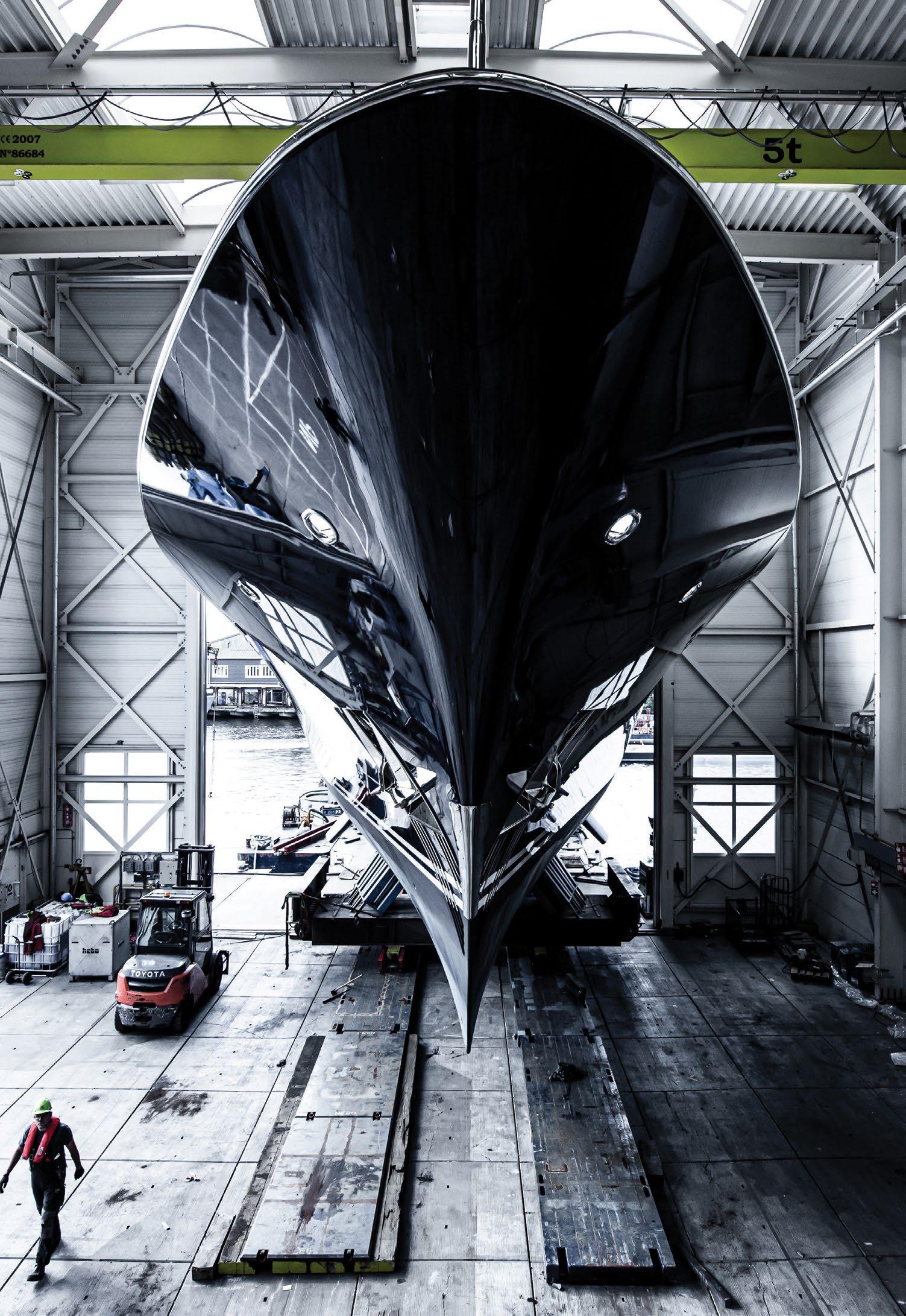
EDITORIAL
EDITOR IN CHIEF
EDITOR | HOW TO BUILD IT
EDITORIAL CONTRIBUTOR
NEWS EDITOR
FEATURES WRITER
WRITER
WRITER
SOCIAL MEDIA MANAGER
CONTENT CREATOR
Francesca Webster
Justin Ratcliffe
Charlotte Thomas
Sophie Spicknell
Enrico Chhibber
Ellen Ranebo
Andrea Pefianco
Marina Vargas
Nick Smits
DESIGN PRODUCTION
CREATIVE DIRECTOR
GRAPHIC DESIGNER
Ivo Nupoort
Beatriz Ramos
INTELLIGENCE
HEAD OF INTELLIGENCE
RESEARCH ANALYST
DATABASE MANAGER
YACHT HISTORIAN
Ralph Dazert
Adil Zaman
Syrine Mellakh
Malcolm Wood
SALES & ADVERTISING
HEAD OF SALES
SALES MANAGER
SALES MANAGER
SALES MANAGER
SALES MANAGER
CLIENT SERVICE MANAGER
SALES ITALY
Marieke de Vries
Justus Papenkordt
Daniel Van Dongen
Charly van den Enden
Nuri Ozkaya
Johanna Borreli
info@admarex.com
CORPORATE
FOUNDER & DIRECTOR
TECHNOLOGY DIRECTOR
FINANCE DIRECTOR
Merijn de Waard
Fabian Tollenaar
Laura Weber
SuperYacht Times B.V. Silodam 256, 1013 AS, Amsterdam, The Netherlands 31 (0) 20 773 28 64 info@superyachttimes.com www.superyachttimes.com
Cover Images:
Project Thunderball by CRN Argo 54 by Omikron MTU by Justin Ratcliffe
How to Build It is published by SuperYacht Times B.V., a company registered at the Chamber of Commerce in Amsterdam, The Netherlands with registration number 52966461. The magazine was printed in June 2025.
When the renowned luxury yacht Starfire sought to reimagine its sun deck, only one name could deliver the extraordinary: KMF I Kreative Metallform
The mission? Transform the space into a world-class wellness sanctuary — featuring an infrared sauna, plunge pool, massage zone, and cutting-edge fitness suite — all enveloped within a fully enclosed, 360-degree glass atrium engineered to open and breathe with the sea.
Our German design team brought this vision to life with a bespoke floor-to-ceiling glazing system that appears to float, offering a seamless blend of strength, beauty, and innovation.
The result is an air-conditioned haven of light, views, and unparalleled functionality.

“Guests are in awe. Charter brokers consistently highlight the sundeck gym — it’s a showpiece that gets people talking.”
Paul Duncan - Starfire
At KMF, we take pride in the fact that perfection is our passion

Welcome to the summer edition of How to Build It. In this issue we explore how tradition and transformation are reshaping the superyacht world – from heritage brands adapting to a new era, to bold design concepts pushing the boundaries of what we expect a superyacht to be.
To mark Mangusta’s 40th anniversary, in Business Brief we take a revealing look at the brand’s evolution. Once a byword for power and speed, Overmarine is now embracing engineering innovation and efficiency in a changing market, signaling a shift many legacy players are navigating.
In parallel, the refit of steel-hulled Perini Navi ketch Belle Brise shows how timeless elegance can meet modern expectations. As Lusben strips her back to bare metal, this rebuild project is more than cosmetic – it’s about reconciling the past with the demands of the present.
We also cast a spotlight on radical thinking. Anthos, a concept design from Oceanco and Italian designer Mario Biferali, dares to ask: could a container ship become a luxury vessel, and what are the technical challenges to making it happen? In an industry that prides itself on traditional elegance, Anthos challenges us to see potential where others see limitation.
Meanwhile, the energy transition continues. In New Tech, we examine the promise – and pitfalls – of battery integration. As the sector moves toward hybrid and electric propulsion, builders and owners face a critical question: when is the right time to commit to a battery technology, and how can we futureproof those decisions in an industry with long lead times?
High-speed connectivity is no longer optional. Our AV/IT feature dives into how next-gen marine broadband is finally delivering on its promise, transforming both the guest experience and onboard infrastructure – and presenting new challenges for integrators in the process.
And in our Build Reports, we see these forces converge. Omikron’s Argo 54 and CRN’s Project Thunderball are both ambitious in scale and vision, but what truly unites them is a shared commitment to cross-disciplinary innovation – whether through blending racing DNA with luxury yachting, or merging engineering excellence from northern Europe with Italian flair and flexibility.
Across all these stories, a common thread emerges: this is a sector not just adapting to change, but actively shaping it. I hope they bring you inspiration, insight and a glimpse into the shape of things to come.

Justin Ratcliffe - Editor


27 Business Brief: A Family Affair
Mangusta is 40 years old this year. Long associated with speed, style and power, today the brand is more focused on engineering, efficiency and innovation.
38 Build Report: Cogito Argo Sum
The Argo 54 sailing yacht being being built by Omikron combines raceboat pedigree with superyacht luxury. We visit the project in Greece as it begins the push toward completion
52 Concept in Focus: Contained in a Concept
Can a container ship be converted into a superyacht? Oceanco and Italian yacht designer Mario Biferali certainly think so and developed the Anthos concept to prove it.
60 Build Report: Crossing Borders
CRN’s Project Thunderball sees the shipyard working extensively with northern European subcontractors in a move that is pushing technical boundaries and blending project management cultures.


73 OEM: MTU
Mtu Solutions, the Power Systems Business Unit of Rolls-Royce, is transforming its engine production capabilities in southern Germany by investing in cutting-edge manufacturing technology.
84 Inside Angle: Richard Pearce
The son of a naval captain, Richard Pearce set up his consultancy firm Waterproof in 2013 and has been representing clients in major superyacht projects ever since.
88 AV/IT: Dreaming of Streaming
Fast global marine broadband is finally finding its sea legs. What does this mean for AV architecture on board, and how is it transforming guest control interfaces?
100 New Tech: Batteries Included
When should you commit to a battery technology for a new-build project and will your choice be obsolete by the time the yacht is launched? Read on.
108 Refit & Conversion: Back to Bare Metal
The Perini Navi ketch Belle Brise is approaching the end of a massive refit at Lusben that both honours her classic heritage and ensures she remains relevant in today’s yachting market.
119 Industry Insight: FIT For Purpose
Jeroen van der Knaap of Sea Level naval architects and engineers talks us through the concept of Feature Integration Technology, or FIT for short.
126 Rules & Regs: Tipping Points
Andy King, Director of Stability & Statutory for Houlder design consultancy in the UK, discusses the importance of conducting detailed inclining experiments.

Boating in Figures, a mid-year statistical analysis by Confindustria Nautica (the Italian Marine Industry Association) has reported that 66 percent of Italian superyacht firms are witnessing a slowdown. As in other countries, the industry experienced more complex economic conditions in 2024 following strong results through 2023, leading to a “normalisation” of growth. The association’s market report reveals that high-end yacht manufacturers continue to see strong demand, while smaller craft producers are faring less well. In the superyacht segment, 34 percent of companies report stable or increasing order books, while 66 percent indicate some level of contraction. Of those, half report reductions of up to 5 percent, while the remaining half cite decreases between 5 and 10 per cent. Within the charter sector, respondents are evenly split between those expecting increased turnover and those anticipating stability, while 7 per cent predict a decline of up to 5 per cent. Exports continue to be a major driver of growth and Italy remains the world’s largest exporter of boats and yachts. Data from Fondazione Edison, a scientific partner of Boating in Figures, recorded an all-time high of €4.5bn in exports of Italian-built yachts in September 2024.
Euro Marine Group Ltd, owner of Lazzara Yachts, has secured a US patent for an integrated sea chest and discharge system that streamlines how seawater is managed aboard modern yachts.
Invented by George Chirakadze, President and CEO of Euro Marine Group, it consolidates seawater intake and discharge into a single structural unit embedded directly into the vessel’s hull, effectively removing the traditional web of leaky through-hull fittings. Already designed into models like the Lazzara UHV 100 and flagship UHV 150, the system provides several advantages, including fewer fittings and failure points, reduced corrosion, cleaner hulls, and better maintenance access within the engine room. Each sea chest has a removable threaded standpipe, for example, allowing engineers to service components while the vessel is afloat, reducing downtime. Moreover, as regulators crack down on biofouling and invasive species transfer, the system’s integrated UV sterilizes incoming seawater on entry, minimising marine growth. “This isn’t about flashy technology,” says Chirakadze. “It’s about solving unglamorous problems in a beautiful way.”



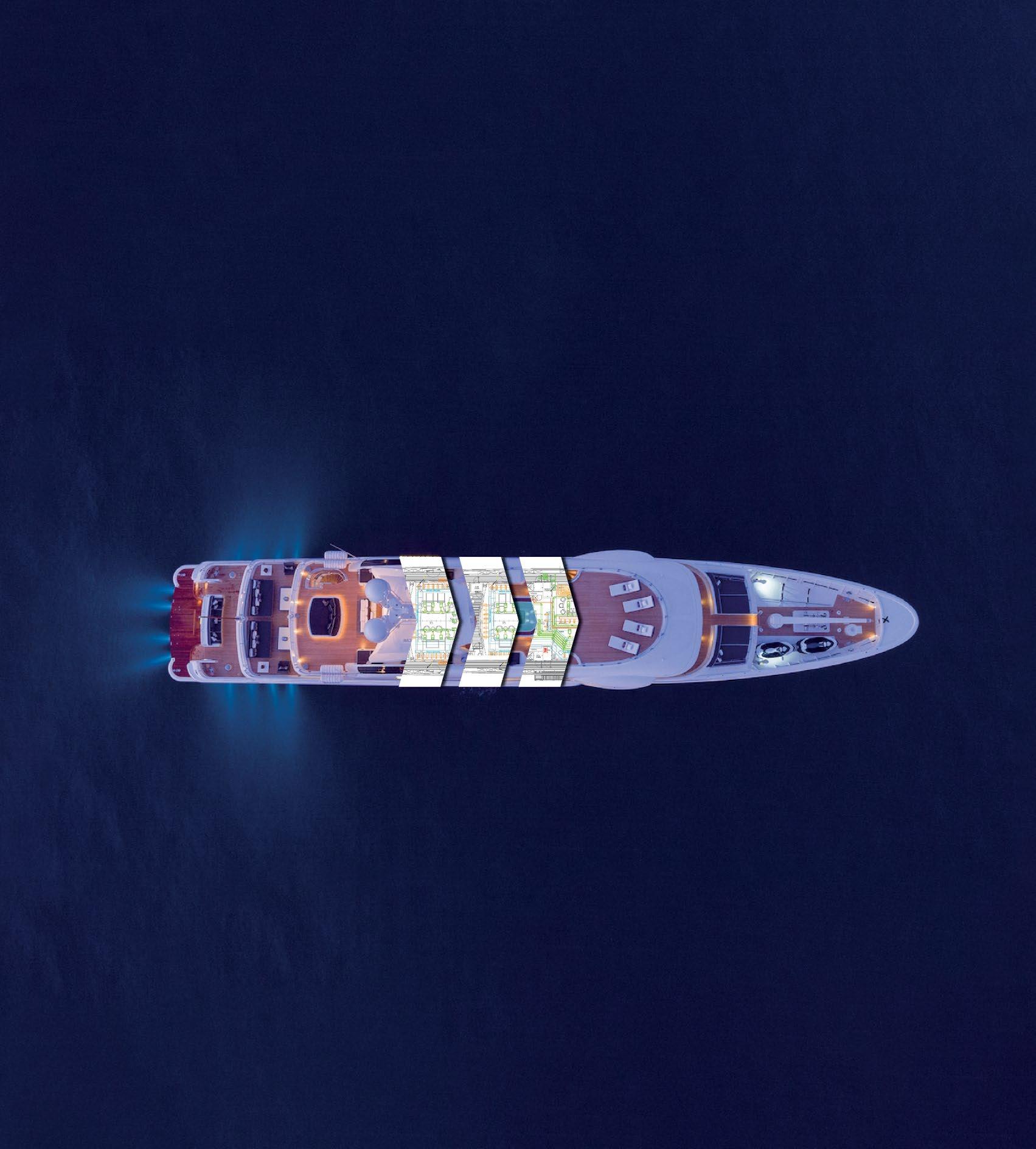
Heinen & Hopman’s HVAC&R solutions seamlessly integrate into your yacht’s design, delivering silent, precise comfort in every space. Our systems ensure optimal air quality, temperature, and humidityallowing you to enjoy every journey in effortless comfort.



GET IN TOUCH WITH OUR TEAM OF SPECIALISTS
Kongsberg Maritime has signed a service representation agreement with G-jet Srl, a leading service provider in the yacht segment and part of the V610 AG group. The company specialises in mechanical and electronic services for Kongsberg Kamewa waterjets, ensuring reliable support for routine maintenance, emergency repairs, and spare parts.
The agreement aims to strengthen this customer support, ensuring yacht clients receive the highest level of service and expertise.
“G-jet has a long-established reputation for delivering exceptional service and support to yacht customers,” says Mateusz Stępkowski, Vice PresidentWaterjets, Global Customer Support at Kongsberg Maritime. “Their proven track record and solid market position make them an ideal partner for us as we seek to enhance our offerings in the yacht segment.”

“This agreement reflects our ongoing commitment to constant improvement, ensuring we meet and exceed the expectations of waterjet clients in the yacht segment,” adds Folena Giulio, CEO of V610 AG. “Together with Kongsberg Maritime, we are ready to raise the bar for customer support and operational excellence in the industry.”
Williams Marine Group, the parent company of Williams Jet Tenders, has expanded its portfolio with the launch of a new standalone brand: Evene Tenders. Its debut Origin 57 is a 5.7-metre superyacht tender equipped with the same Yanmar waterjet drive as a Williams Jet Tender, but with a new rigid hull configuration with no tubes. Clients can customise features and accessories via an online configurator. Production of the Origin Series is underway at Williams’ existing facility in Oxfordshire, with first previews scheduled for the autumn boat shows later this year. An Origin 71 is also planned.
“With our ever-curious nature and pioneering spirit, we are excited to bring an elevated experience to the superyacht sector,” say Group founders Mathew and John Hornsby. “This is a launch that has been decades in the making, but it is just the beginning. The superyacht market has a bright future and with our Evene brand, we’re perfectly placed to fulfill these emerging opportunities.”

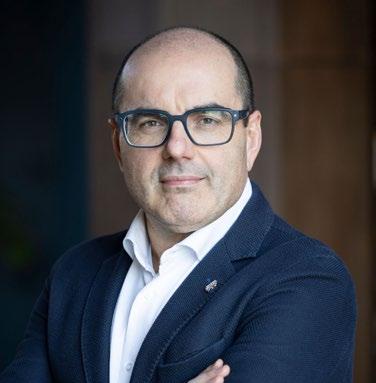
Rolls-Royce has named Christian Paolini as Managing Director and Sales Director of Team Italia Marine, its yacht bridge and automation subsidiary. Paolini, formerly Sales Manager at Rolls-Royce Solutions Italia, brings more than two decades of maritime and tech sector expertise to the role.
With Team Italia Marine based in Fano, Italy, the company has delivered over 700 integrated bridge systems since its founding in 2000. Now part of the mtu product portfolio following its 2023 acquisition, the firm supports Rolls-Royce’s “Bridge to Propeller” strategy – integrating navigation, propulsion, and automation technologies.
Paolini’s appointment aims to ensure strategic continuity and expand the brand’s footprint beyond Italy, with a focus on both custom and standardised yacht solutions. “We’re entering a new phase of bridge technology, with AI and predictive maintenance on the horizon,” said Paolini.
Rolls-Royce sees this leadership move as instrumental in consolidating its position in the luxury yacht market. Denise Kurtulus, SVP Global Marine at Rolls-Royce Power Systems, noted: “Christian will guide our Italian specialists into a promising future, leveraging the global strength of the mtu brand.”
The MC² Quick Gyro CARE Agreements offer premium service, ensuring long-term performance, reliability and peace of mind for every journey.
Benefit from priority assistance, fixed maintenance costs, and original spare parts by choosing flexible plans up to five years! More than just a product – a commitment to quality, performance, and customer satisfaction.


MC² Quick Gyro reduces boat roll up to 95%, ensuring comfort onboard at anchor and underway. The range has been designed to meet any requirement, with no installation limits both on new build and refit, from small day cruisers to superyachts.
Easy to install, with no water pumps or additional seawater intakes, Quick Gyro stabilizers are absolutely silent and compact.
For those who believe a white yacht is just not enough, Alexseal has introduced an online Colour Configurator designed to simplify and personalise the yacht painting process. The tool offers users access to over 1.7 million potential colour combinations using 121 solid and metallic finishes. Traditionally, shipbuilders and designers have relied on physical paint samples to visualise finishes. This new digital tool streamlines that process with photorealistic renderings of various vessel types – ranging from sailing yachts and sportfish boats to superyachts. Users can apply colours to different sections such as the hull, superstructure and bootstripe, with real-time updates displayed onscreen.

A 3D viewing lens allows for close-up inspection of colour application on complex shapes and surfaces. Additionally, selected colour schemes are automatically saved and can be transferred between different yacht profiles, helping designers and owners envision coordinated fleets, including tenders and toys. Finally, users can download a PDF summary of their selections for reference or to share with design teams and builders. The configurator provides a practical, flexible alternative to physical swatches, offering greater creative freedom and precision in the yacht finishing process.
Filling your glass with drinkable water from the tap on a yacht – including sparkling water at the temperature you prefer – makes perfect sense instead of stowing hundreds of plastic bottles on board. The GENIUS drinking water dispenser by HP Watermakers is now lighter and easier to install than before. The new edition coupled with the top-of-the-range HP SCA DOUBLE 440 watermaker and directly connected to a tank-linked water distribution system, produces purified chilled and/or sparkling water directly from the tap in the galley, where the device is usually installed. The ultrafiltration system removes all traces of chlorine, trapping bacteria and pollutants with the potential to contaminate water as it travels from the tank to the tap. The bactericidal silver ion treatment system also sterilises the water at the point of exit. Lastly, a re-mineralising filter enriches the water with precious minerals, giving it a pleasant taste.

Awlgrip has unveiled Gloss Finish Primer, a new product designed to save time, reduce emissions, and improve finish quality during the superyacht painting process. The next-generation, low-VOC primer merges two key functions – primer and control coat – into a single application. It delivers a high-gloss finish that enables applicators to instantly spot and correct imperfections before the final coat, eliminating rework and reducing the number of applications required. Developed specifically for the demands of new superyacht projects, the Gloss Finish Primer is part of Awlgrip’s high-performance coatings system. Its advanced formulation features a higher solids content than conventional two-coat systems, helping to cut VOC emissions by up to 50 percent per square metre in line with the brand’s commitment to supporting professional applicators with smarter, more sustainable solutions. “We created Gloss Finish Primer with efficiency, durability, and superior finish in mind,” says Jemma Lampkin, Global Commercial Director for AkzoNobel Yacht Coatings. “It allows professionals to simplify their workflow and achieve flawless results faster. This innovation responds directly to industry demand for faster project turnaround, lower material use, and outstanding quality.”


During Milan Design Week 2025, Officine Gullo, a luxury kitchen producer based in Florence, presented a new collection of galleys and bar units designed specifically for superyachts. The line brings the brand’s signature craftsmanship and attention to detail to the world of luxury yachting, with custom cooking and bar areas that blend design, functionality, and durability.
Traditionally hidden, yacht galleys are re-imagined as welcoming, social spaces. The collection features multifunctional islands, cooking stations and elegant bar units that integrate seamlessly into the yacht’s layout, providing aesthetic value and practical use. Made from high-grade AISI 316 stainless steel, each piece is built to withstand marine environments and can be customised in various finishes. The range includes fitted counters, appliances, and professional-grade BBQs, all tailored to the specific needs of each yacht.
Evac Group, a global leader in sustainability technologies and solutions, has launched Dehydro, an innovative onboard waste management system designed to meet the specific needs of today’s superyachts by using dehydration technology. At a time of stricter regulations on waste disposal to protect marine ecosystems, the new Dehydro system incorporates a high-temperature drying process of up to 180°C to sterilise and dehydrate organic waste, reducing wet waste volume by approximately 80 percent. The system also incorporates features such as, embedded crushing technology and patented de-odorising methods to handle complex odours, generating a sterile, dry by-product.
“The launch of this product marks a key moment for Evac,” says Björn Ullbro, CEO of Evac Group, which already has waste systems installed on over 20,000 vessels worldwide. “Traditionally, innovation in our industry meant developing a great product and then bringing it to market. This time, we reversed that. We started with the customer’s operational reality and identified the best solutions on the market. Complementing in-house innovation with strong partnerships is a clear example of how we’re delivering on our ambition to offer the industry’s most comprehensive water and waste management portfolio.”

BY FRANCESCA WEBSTER

This year marks a milestone for Austrian outfitting specialist List GC, celebrating 75 years of craftsmanship and innovation. With a legacy rooted in precision joinery and a portfolio that spans some of the world’s most iconic superyachts and residences, the company stands at the forefront of bespoke interior outfitting. Christian Bolinger, one of the Managing Directors, speaks with How to Build It about the evolution of the business, the power of long-term partnerships, and what lies ahead.
List GC is celebrating 75 years in business and over 25 years in the superyacht sector. How has the company evolved over that time?
We began as a small local joinery in rural Austria. The first major shift came when Eastern Europe opened up – that gave us access to large-scale hotel projects, which really drove growth. Then came our first cruise ship interior in the late 1990s – the MS Deutschland. It wasn’t an easy introduction to maritime interiors, but it put us on the map. From there, we gradually moved into yachting –beginning with Oceanco around the early 2000s –while still handling hotel and cruise interiors. By 2012, we made a strategic decision to focus exclusively on the superyacht and high-end residential sectors. These markets demand precision, complexity and an uncompromising level of quality – it was clear we needed to align our DNA with that standard.
How would you describe the company’s structure and scale today?
We’re now around 340 people across our Austrian headquarters and our German daughter companies. In the last decade, we invested heavily in our own production facilities – a move that made us more independent and resilient.
We’ve grown from a project management-driven operation into a turnkey outfitter, with around 60 percent of production now in-house. The remainder is handled by long-standing partners, which allows us to maintain flexibility while ensuring quality. That partner network is carefully managed and fully transparent to shipyards and clients alike.
You’ve also made some key acquisitions in recent years. What value have they brought?
We’ve acquired two German companies that were already established suppliers in the yachting industry, Cohrs Werkstätten GmbH and Riederle Werkstätten GmbH –both family-run, with a strong heritage. These integrations have allowed us to increase capacity and gain new knowledge in return. It’s not just about scale – it's about expertise, culture and a shared commitment to quality.
Most recently, we acquired a stake in Interior PROMAN GmbH, a 12-person engineering and project management firm. Many of their team previously worked with List GC, so it was a natural fit. The acquisition has strengthened our internal capabilities and enhanced our ability to deliver on complex projects.
Technology clearly plays a role in your evolution. How does it shape your work today?
Technology touches everything – from process engineering to final fit-out. On one side, we’ve invested in digital tools like 3D engineering, CAD/CAM integration, and additive manufacturing. We currently run six 3D printers full-time, which support both prototyping and process development.
On the other side, we focus on integrating innovation in a way that supports design intent. Much of our R&D isn't about visible change – it's about what sits behind the finish, ensuring technical feasibility and longevity without compromising aesthetics.
We also collaborate closely with designers to help realise their vision. That balance – between creativity and practicality – is where our technical strength becomes invaluable.
You’ve spoken about managing complex stakeholder relationships. Can you expand on that?
Yacht interiors are always multi-stakeholder environments. The designer, the shipyard, the owner’s team – we’re often contracted by one party while delivering on the vision of another. That makes stakeholder management critical.
We train our teams in communication, cultural sensitivity and transparency. Long-term partnerships with shipyards help too – they enable us to maintain consistent teams who understand each other’s expectations and workflows. In this business, trust is earned over years, not months.

How does your heritage as a family business shape your culture today?
List GC remains family-owned, and that ethos runs deep. While day-to-day management is in the hands of Josef Payerhofer and myself, we work very closely with the List family, who remain actively engaged.
It’s not just about governance – it’s about values. The family presence creates continuity, trust and accountability. Many of our employees have been with us for decades, and that stability translates into consistency for our clients.
And finally, which projects are you particularly proud of?
It’s always difficult to name names, given confidentiality, but we’re proud of the diversity of work we’ve delivered – from 30-metre high-performance sailing yachts such as Ribelle to full-scale 100-metre-plus new-builds like MY Ahpo, where we were commissioned with the project management of the interior design on four decks and a total of 745 m².
What I find especially rewarding is when we can support repeat platforms with shared teams – it streamlines delivery and deepens collaboration.
What’s next for List GC?
We’re committed to controlled, sustainable growth. That includes continued international expansion and greater diversification in the high-end residential space, particularly through cross-selling to yacht owners. We’re also seeing growing demand for our services beyond Northern Europe – in regions where clients want Northern European quality but choose to build elsewhere. We’ve already delivered projects under that model, and it’s a space we’ll continue to explore. Above all, we want to stay true to who we are: a trusted, technically skilled partner who helps bring the most ambitious interior visions to life.
Find out more and reach out to the team now at www.listgc.at | mail@listgc.at

New projects in early stages of construction that present opportunities for OEMs, suppliers and subcontractors.
Project Omega will feature both exterior and interior design by RWD and naval architecture by Lürssen. She will be able to accommodate up to 20 guests across 10 staterooms. The superyacht will be equipped with a beach club, a dive centre, and ample outdoor spaces designed for entertainment and relaxation.
LENGTH: 122.5-metres BUILDER: Lürssen Yachts
NAVAL ARCHITECTURE: Lürssen Yachts

EXTERIOR & INTERIOR DESIGNER: RWD
Lazzara Yachts’ new model marks the shipyard’s entry into the expedition segment, with construction due to begin in early 2026. Constructed with a steel hull and aluminium superstructure, the Lazzara EX 165 will come in at just under 500 GT and is designed for long-range cruising.

LENGTH: 50-metres BUILDER: Lazzara Yachts
NAVAL ARCHITECTURE: Lazzara Yachts
EXTERIOR DESIGNER: Lazzara Yachts INTERIOR DESIGNER: N/A
Composed with a steel hull and aluminium superstructure, the displacement yacht has been designed for ocean crossings and is the result of a collaboration between renowned designer Enrico Gobbi of TEAM for Design and the technical department of Palumbo Superyachts.
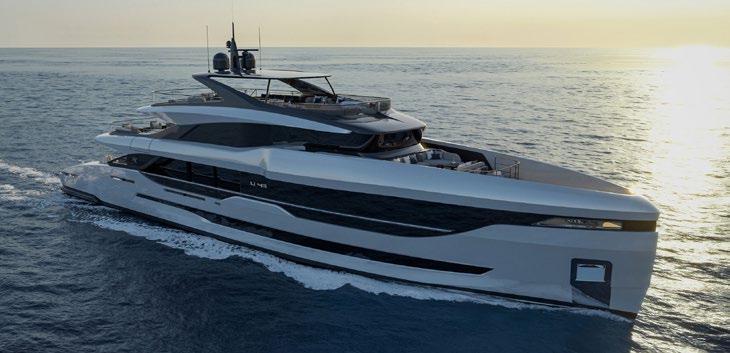
LENGTH: 45-metres BUILDER: ISA GT: 440 GT COUNTRY OF BUILD: Italy DELIVERY YEAR: 2027
NAVAL ARCHITECTURE: Palumbo Superyachts
EXTERIOR & INTERIOR DESIGNER: Team for Design
Cantiere delle Marche (CdM) has announced the sale of the first 32.01-metre RAW 105 yacht. The CdM yacht features a bold, yet strong exterior design and derives from the RAW series, which was first announced in September 2024.

LENGTH: 32.01-metres BUILDER: Cantiere delle Marche
GT: 250 GT
NAVAL ARCHITECTURE: N/A EXTERIOR DESIGNER: Giorgio Cassetta
Comprising a steel hull and aluminium superstructure, once complete ALY651 will be the flagship for the Turkish yard. ALY651 showcases a five stateroom configuration, with her owner’s suite boasting a private lounge area and floor-toceiling windows.
COUNTRY OF BUILD: Italy DELIVERY YEAR: 2026
INTERIOR DESIGNER: N/A

LENGTH: 65-metres BUILDER: Alia Yachts
NAVAL ARCHITECTURE: Diana Yacht Design
GT: 1,400 GT
COUNTRY OF BUILD: Turkey DELIVERY YEAR: 2028
EXTERIOR & INTERIOR DESIGNER: Sinot Yacht Architecture & Design
With an expected delivery date of 2027, the Columbus Crossover 47 yacht combines contemporary aesthetics with functionality and stems from the same platform as the Columbus Crossover 42 model, which is also in-build.

LENGTH: 47-metres BUILDER: Columbus Yachts GT: 499 GT
NAVAL ARCHITECTURE: Palumbo Superyachts
COUNTRY OF BUILD: Italy DELIVERY YEAR: 2027
EXTERIOR DESIGNER: Hydro Tec
INTERIOR DESIGNER: Hot Lab
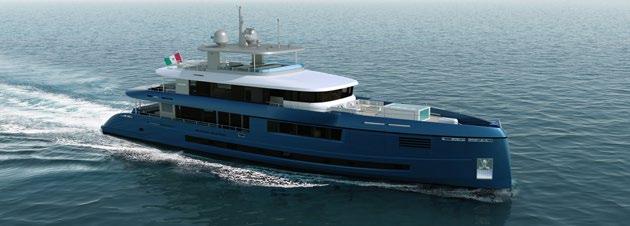

Advertisement

For 75 years, Wards Marine Electric has been the unseen force powering your dining, sailing, and onboard connectivity for the ultimate yachting experience.

Marine Part Sales
Engineering
Surveys
Custom Panels
Refits
Painting
Dockside Services
Engraving
Suppliers
Dockside Rentals
@wardsmarine
wardsmarineelectric
@wardsway75


Dutch production and engineering firm Beekmans began life building steel hulls for Trinitella yachts in 1960. Since then it has delivered stainless steel and glass installations – encompassing railings, balustrades, telescopic awnings, staircases and pool glass – to approximately 200 superyachts. Specialising in vessels between 60-120 metres, projects include Nobiskrug’s Artefact, Delta Marine’s Moonstone, Lürssen’s Octopus, and Oceanco’s Kaos.
BY GEORGIA TINDALE
The blueprint for Beekman’s approach today was formed in the 1970s: instead of positioning and welding bollards on yachts, the process was standardized and the bollards were bolted onto a yard-supplied double plate. This was the starting point for preproducing components and improving efficiency. Finding modern, technical solutions to the issues that occur on board is where Beekmans finds its raison d’être “Machine-building employs methods which are far ahead of yacht building, which is still very traditional,” says Sales Manager Mike Gilsing. “We integrate these into our products and processes to boost quality and efficiency. Yacht building is sometimes old-fashioned, so we use this to our competitive advantage.”
Twenty-five years ago, when the industry was still measuring by hand – using pencils and cardboard templates placed on top of bulwarks – Beekmans introduced digital measuring with laser scanners placed on tripods: a far more precise technique which is now widespread. These highly accurate measurements can be taken on any global location and then be inputted into 3D programs, ready for production modelling. This technique was put into practice when the captain of the 62-metre Oceanco Queen Mavia asked Beekmans for a new sundeck windshield that was the same as its sistership, 63-metre Lucky Lady, by removing the toprail that obscured the horizon. Measurements for the windshield were taken in Asia, and it was installed just three months later on the other side of the world during the Cannes Film Festival.

Beekmans brought glass production in-house in 2017 in response to the decreasing quality of glass provided by its external suppliers. Consistently falling below durability and strength standards, this had been causing project delays – a frustrating obstacle, particularly for the shorter timelines required by its numerous refit projects. A portion of Beekmans’ 9,000-square-metre Den Bosch facility is dedicated to a CNC glass center, glass cutters, laminating area and chemical toughening bath, to produce glass that complies with Lloyds Register and other class society standards.
“Producing both the glass and stainless steel ourselves is unique,” says Gilsing. “Even when working with shipyards such as Heesen, which is only a 30-minute drive away, this is a major driver of efficiency and enables us to control delivery times. If we produce a railing for them, we can measure the yacht wherever it is located and then build the whole product in our workshop, knowing that everything fits and meets our standards. We only weld and polish on board when it is impossible to avoid, as working on board always takes triple the time.”
Beginning with glass windshields as early as 1999, Beekmans has also been tasked with creating all-glass railings in response to changing design preferences. “The trend is for owners seeking greater contact with the sea and their surroundings by having more glass in the general structure of their yachts, and the same principle applies to railings,” says Gilsing. The extensive refit of the Amels Here Comes the Sun in 2021, in which Beekmans’ team installed an all-glass railing on the aft deck, is one such example.
Notably, there is a balance to be struck between pleasing aesthetics and feelings of safety for those on board. The 90-metre Oceanco motor yacht Dar features fully glass bulwarks with a profile on top.
“I would always advise to put something on top of your glass balustrade, whether it be stainless steel or teak”, comments Gilsing. “It can be very subtle, but if guests can only see glass, they might be scared that the railings won’t work, so this provides a sense of psychological security.”
Looking to the future, Beekmans has plans to develop a new product: high-tech portlights that bypass the requirement for deadlights or storm covers, thanks to the strength of the glass, which is set to be significantly higher than standard values for Class approval.
“Security deadlights have to be put somewhere, and although yachts are big, there is never enough space,” explains Gilsing. “Moreover, with this product, no provisions will have to be made in the interior design for bolting in the deadlights.”
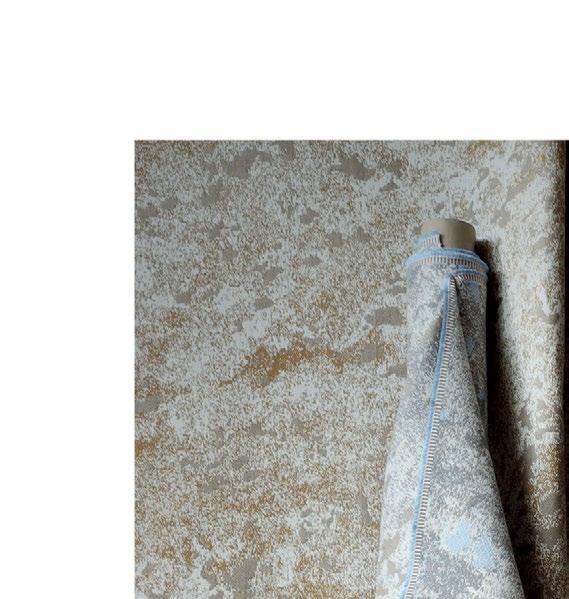

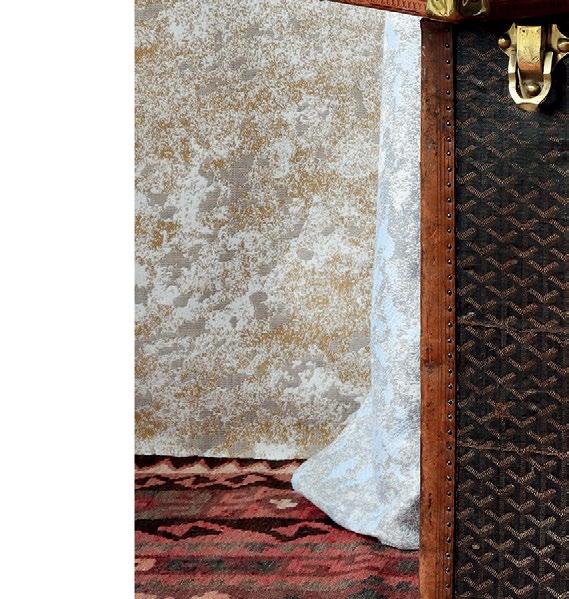







INTRODUCING BELLUS & LINEOS: A REFINED INDOOR AND OUTDOOR FABRIC MADE FROM SOLUTION-DYED ACRYLIC
AVAILABLE IN WARM SOPHISTICATED & INTENSE COLOURS BLENDS DURABILITY WITH A SOFT LUXURIOUS TOUCH THAT ELEVATES BOTH COMFORT AND
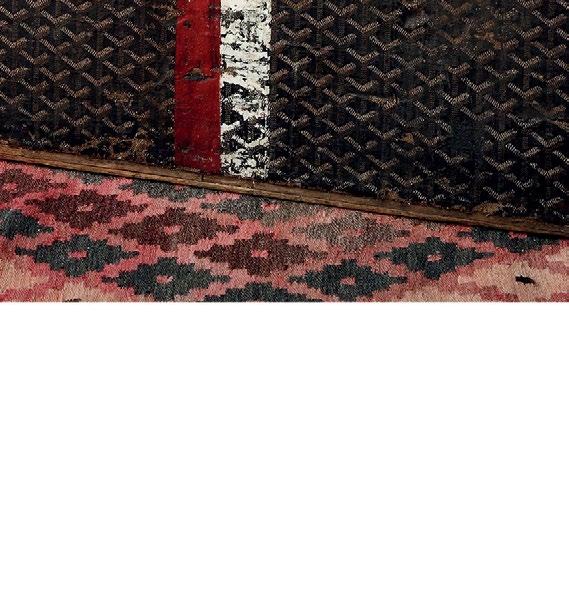



Beginning with 126-metre Octopus in the 1990s, GL Yachtverglasung near Hamburg has developed, designed, delivered and installed glass on board some of the world’s most recognisable superyachts, including Sailing Yacht A, Artefact, REV Ocean, Solaris, Excellence, and more. CEO Lars Engel discusses the challenges posed by sanctions, and how a passion for complex and spectacular projects has driven business success to date.
BY GEORGIA TINDALE
What drives you to succeed in business?
Passion. You need passion to work in such a niche industry, and also to have an understanding of what happens every day behind the doors of a construction hangar. The outcome at the end is something exceptional. Passion is necessary because without it you won’t be driven to follow through in such a complex business. When we first worked on Octopus, it was so enjoyable that I decided that we needed to start a whole new company specialising in glass for spectacular yachts. The element of fun is very important to me and the team as a whole. We’re not interested in delivering a set number of projects per year, but in rising to the extraordinary challenges posed by individual projects.
Are there any specific strategies you’re planning to tackle future challenges and ensure continued growth?
We specialise in larger superyachts – the minimum is 70 metres, occasionally a little less, but only when it involves very complex glazing. The current major obstacle is overcoming the sanctions, which are a showstopper for our niche market. The relevant question isn’t one of growth, but the justification for the future of an entire industry. To combat this and in response to requests, we have been motivated to identify and create a new niche, which is a work in progress. Because yachting is a project-based business, we know and accept that our results will go up and down. We can mitigate this because our main business, GL Spezialverglasung, provides special glazing for public and private transport companies as a supplier, repair and spare parts service provider.
What proportion of your work is in-house?
There is a very limited number of companies – not more than about five – we partner with to source the glass we need for our projects. The market simply doesn’t offer the quality of people and knowledge we require, so we basically only work with our own employees. When taking on projects, we are very careful about the resources we use and managing our capacities sensibly. To this end, we offer support for designers and engineers from various industries, the execution of installation works on new build projects, and overall after-sales and services, so our clients get 360-degree project management. This provides both them and us with a greater degree of security.
How important is staff training?
Training is very important to us: all our technicians are extremely well qualified. Once they start with us, they receive training to become bonding specialists. It takes around 18-30 months to get them to the point where they can deliver the workmanship we expect. Between both our companies, we employ nearly 200 people and around 150 technicians who need to be retrained every year, so it is a huge investment for us. Thanks to the experience and expertise of GL Spezialverglasung and close collaboration with renowned research institutes, we are the first company worldwide with DIN 2304 certification, the quality assurance for adhesive bonding processes.
You installed the longest curved glass panel ever made onto Nobiskrug’s Sailing Yacht A. What are the complexities of working at that scale?
As with many of our projects, this required us to think beyond the existing limitations of what is perceived to be possible. On Sailing Yacht A, it wasn’t just building and installing the world’s longest curved glass panel of 15 metres, but also creating and installing the underwater windows, which presented unprecedented complexity. This is why we’re continuously identifying new methods, equipment and engineering to make ‘mission impossible’ possible.
There’s also the question of logistics. On Solaris, for example, the largest glass pane was 12 metres by three metres and weighed 5.2 tonnes. Everything was over the limits for the transport of the glass, so we had to develop and find new solutions. When we first sign our projects, we don’t always know what will be possible, but we always make it happen, thanks also to our strong R&D department.
As a company, we love intricate and challenging builds. Our latest 114-metre project has a special arrangement on one of the decks that has never been realised in glass until now. It’s a yacht that doesn’t look like a yacht, so you will either love it or hate it!










































www.multiplexgmbh.com




































































Mangusta celebrates its 40th anniversary this year. Long associated with the speed, style and power of its Maxi Open yachts, a quieter revolution has been unfolding and today the brand is more focused on engineering, efficiency and innovation.
BY JUSTIN RATCLIFFE


The origins of Mangusta read like a case study in bold entrepreneurial thinking. In the early 1980s, Giuseppe Balducci – a young marine electronics engineer from Tuscany – walked away from Tecnomarine, which dominated the fast yacht market at the time with its Cobra range of open yachts capable of speeds in excess of 35 knots. He set up Overmarine in Viareggio with the aim of building his own boats in a move that was both strategic and symbolic.
Balducci’s choice of brand name – Mangusta is Italian for mongoose, the small but fearless predator that devours cobras – made his intention crystal clear. Overmarine went on to build 85 units of the Mangusta 80, while steadily gaining ground as a pioneer of Maxi Open yachts, overtaking its rival and establishing a reputation for performance combined with stylish Italian design.
Giuseppe Balducci continued to work right up until his death last year aged 87, but the company he founded is still headed up by his children, Maurizio and Katia Balducci.

Until a decade or so ago, Mangusta’s legacy was rooted in composite construction and high-speed performance with a shifting lineup that ranged from the Mangusta 72, the entry model equipped with Arneson surface drives and a top speed of 40 knots, up to the mighty Mangusta 165 powered by triple mtu 4000 series engines coupled with RollsRoyce KaMeWa waterjets. Then the 2008 financial crisis came along and the economic downturn that followed led to a decisive change of strategy.
“The drastic market slowdown from 2010, especially for luxury sports boats, led to an influx of used vessels returning to the market due to leasing complications, which made it difficult for us to sell new units at competitive prices,” recalls Maurizio Balducci, CEO of Overmarine Group. “Ironically, these used Mangustas, still in excellent condition, became our biggest competitors, so we decided to enter a different segment with different products.”
In an entirely new direction for the brand, Overmarine turned its attention to displacement yachts in steel and aluminum.
With this in mind, the group joined the bidding for the bankrupt Baglietto and Cantieri di Pisa brands, but setbacks led to it abandoning the attempt. In 2012 it announced its own 22,000-square-metre facility purpose-built in Pisa for metal construction up to 70 metres.
The same year marked the debut of its first full-displacement yacht, the Mangusta Oceano 148. The composite design by Stefano Righini recalled the styling of its open range, but it was the precursor to the Mangusta Oceano 42 Namasté, Overmarine’s first steel and aluminium tridecker designed by Alberto Mancini that introduced a completely fresh aesthetic to the brand in 2016. The current Oceano line-up of six models from 39 to 60 metres is now Mangusta’s largest range.
Mangusta’s shift from composite-only to metal construction brought with it a major learning curve. Initially supported by external consultants, the team quickly developed in-house expertise and today the technical office in Pisa employs around 15 engineers and designers who can handle all the key design phases from naval architecture through to interior outfitting.

Building in metal requires more preengineering than composite construction and this meticulous mindset has been carried back into the technical design of the yachts at the heart of its heritage – the high-performance Maxi Opens. Far from the popular perception of these as simply very fast day boats for blasting along the French Riviera, evolving client needs means they also have to offer comfort for extended cruising. Family-friendly layouts, larger crew quarters, and a practical balance between interior and exterior spaces are other key selling points. While performance is still an essential ingredient, there was also growing concern about fuel efficiency.
“Initially, our goal was to build the fastest luxury boats on the water,” says Nicola Onori, Overmarine’s technical director. “But over time, we realised there was much more value in optimising for fuel efficiency, onboard
comfort and sea-keeping across a range of speeds – not just at the top end.”
A case in point is the evolution of the Mangusta 165. Originally outfitted with three mtu 4000 series engines delivering 3,440kW each, it could reach a blistering 42 knots. But the trade-off was high fuel consumption. Since 2016, the Mangusta 165 has been fitted with four smaller mtu 2000 units of 1,930kW each, delivering a slightly lower top speed, but offering up to 30 percent better fuel efficiency in cruising conditions. This shift wasn’t just about the number and power of the engines – it also allowed for smarter weight distribution, ultimately improving balance and responsiveness without sacrificing the brand’s performance DNA.
“It all boils down to power-weight ratio”, says Onori. “To build high-speed yachts, you want light but powerful engines. Lighter yachts also mean more speed for less fuel, which in turn means lower emissions. The three mtu
“Everything we’ve learned from building fast boats has been carried over to this new generation of semi-displacement metal yachts.”

4000 series engines weren’t specifically designed for marine use, and at around 13 tonnes with their gearboxes they were big and heavy. The latest generation 2000 series weigh less than half as much, so we’re already saving a lot of weight.”
Overmarine’s Maxi Open range today includes the entry model Mangusta 104 REV – a far cry from the Mangusta 72, the entry model ten years ago – and the Mangusta 165 REV, both designed by Igor Lobonov (a third model, the Mangusta 132E, is not due to be continued beyond the two units in-build).
The composite hulls and superstructures are manufactured in Massa and then transported to the facility in Viareggio for outfitting. In a significant example of precision tooling, the mould for the Mangusta 165 REV is now CNC-milled in sections then assembled into a single piece to ensure a perfect match with the digital design, eliminating inconsistencies and streamlining later stages of production.
Moreover, Overmarine is one of very few shipyards that produces its own fibreglass and other composites through its subsidiary company Effebi Spa, which allows for extensive testing and optimisation of both materials and lamination techniques (the company is also experimenting with natural fibres such as basalt in combination with bio-resins, but not for major structural components).
“While many yards use sandwich construction for the hull, we prefer singleskin construction,” says Onori. “Although a sandwich structure reduces weight, we believe a single-skin hull offers better vibration resistance and mechanical strength in the event of impact. So our hulls are single-skin and laid up by hand, but we do use vacuum infusion for the upper decks and superstructure. We also use carbon fibre where necessary – primarily to reduce weight and improve rigidity, especially in the superstructure.”
Top: The Mangusta GranSport 54 El Leon was the first Mangusta to cross the Atlantic and cruise around the world. Facing page: Outfitting the engine room aboard a Mangusta 165 REV in Viareggio.
Overmarine’s strength lies in its ability to manage controlled complexity across build materials, propulsion architectures and model lifecycles at its facilities in Massa, Viareggio and Pisa. Nearly all the major construction and outfitting proceses are carried out in-house, thanks also to specialist subsidiaries Effebi and Elettromare being part of the group.
Current production is based on three lines: Mangusta Oceano, Mangusta GranSport, and Mangusta Maxi Open REV, each tailored to a distinct style of yachting.
The Oceano line designed by Alberto Mancini is the tri-deck displacement series built for ocean-going capability in steel and aluminium with a focus on comfort, volume and extended cruising range. The six models in the range from 39 to 60 metres prioritise onboard comfort and range over speed.
The GranSport line, also designed by Mancini, combines high performance with long range. The GranSport 33, 45 and 54 are designed for cruising at fast displacement speeds without sacrificing efficiency, comfort or style. Blending sporty lines with generous living spaces, the series offers a more dynamic yachting experience. All but the entry GranSport 33 are built of aluminium.
Lastly, the open-style models in the composite Maxi Open line define the brand’s design DNA. Focused on speed, elegance and on-the-water lifestyle, the planing Mangusta 104 REV and Mangusta 165 REV capable of 35-plus knots are designed by Igor Lobanov (the outgoing Mangusta 132E is an in-house design).




Mangusta debuted the first Mangusta GranSport 33 at the 2020 Fort Lauderdale Boat show in the midst of the Covid pandemic. The entry-level composite model in its fast displacement series (since extended to 34 metres to accommodate SCR units and the only one with Volvo Penta IPS propulsion) with exterior design by Mancini was joined by the all-aluminium GranSport 45 and GranSport 54. Together they represent a happy median between the Maxi Open line and the more cruise-oriented Oceano range, and lessons from both have been integrated into their technical design.
“We maintain focus on advanced hull design, efficient appendages, optimised weight distribution, and weight savings wherever possible,” says Onori. “Everything we’ve learned from building fast boats has been carried over to this new generation of semidisplacement metal yachts.”
In collaboration with Pierluigi Ausonio Naval Architects, Overmarine came up with what they call the Fast Surface Piercing Hull or FSPH, basically a round-bilge hull form with bulbous bow hull that cuts through the sea surface without planing. Together with the four-engine configuration perfected for the Mangusta 165, the hull design allows for high speeds with relatively low installed power. In the case of the GranSport 54, it also provides an oceanic range of 4,800 nautical miles at 12 knots and 3,500nm at 14 knots. In fact, in 2018 the GranSport 54 El Leon (her owner’s fourth Mangusta) became the first Mangusta to cross the Atlantic Ocean and went on to complete a world tour of 52,000 nautical miles.
Although Mangusta has made meaningful strides in propulsion efficiency and all its yachts are HVO-ready, it has not yet built a yacht with hybrid propulsion. Rather than lagging behind competitors in the energy transition, this is the result of a strategy focused on meeting client expectations and optimising efficiency within practical limits.
“We’re in a transitional phase and multiple solutions are being explored across the industry, but no definitive single path has so far emerged,” says Balducci. “We’re evaluating emerging propulsion systems such as methanol and dual-fuel engines, but technical limitations remain – especially the space required for alternative fuel storage, which is often incompatible with yachts under 500GT. Instead, we’re doing everything possible to achieve the best performance within the dimensional and regulatory constraints.”
Mangusta’s operational geography reflects the brand’s response to an evolving market. Ten years ago it was all about Europe, especially France, where there is still a legacy office in Golfe-Juan. Today, the US is its biggest market and served by an office in Miami Beach headed up by Stefano Alunno, whose local knowledge of customer needs helps preempt requests and provide turnkey solutions.
The brand’s presence is growing in the Middle East, where notably at this year’s Dubai International Boat Show a Kuwaitiowned GranSport 33 generated strong interest and high-quality leads. Dubai’s strategic appeal lies in its cultural diversity, but Turkey has a ready-made yachting culture with strong potential for growth. Overmarine now has a direct representative in Bodrum, a former Mangusta captain deeply familiar with the product who has already sold a Mangusta 165 into the country, for instance.
“Markets shift a lot over time and what was true ten years ago has already changed,” adds Arianna Toscano, head of image and communication. “The idea is to expand beyond our traditional markets, but in a sustainable way that doesn’t over-extend our production resources.”
Perhaps the most old-fashioned – and quietly powerful – part of Overmarine’s approach is its relationship with its clients. Mangusta yachts often remain with their original owners for a decade or more – a rarity in a world of quick trades and fleeting fashion. As Balducci points out: “We don’t advertise much. Our best marketing is a satisfied client.”
Mangusta’s evolution is a story of quiet leadership where long-standing values meet forward-thinking design, and where each yacht is still, at its heart, a family affair. This philosophy is rooted in making purposeful products that speak for themselves, relying on word-of-mouth and high build quality to grow the brand – a refreshingly deliberate approach in an industry often driven by glitz and spectacle.

From the glistening hulls of Mediterranean icons to the precision-applied coatings on explorer yachts far afield, the name Nautipaints Group has long been synonymous with excellence in superyacht paint refinishing. With operations spanning nearly fifteen locations worldwide – from Palma and Barcelona to Genoa and La Ciotat – the company has built a reputation for delivering refined, resilient finishes that mirror the expectations of the most discerning clients.
At its core, Nautipaints remains dedicated to the meticulous craft of paint refinishing and refit services –a discipline the group has elevated through obsessive attention to quality, a commitment to artisan-level techniques, and an ever-expanding suite of specialised underwater and surface treatments.
Quality control as a cornerstone
“A paint project is like a journey,” says Nautipaints CEO Toni Salom, “with well-defined waypoints guiding us towards a flawless finish.” It’s a philosophy grounded in decades of expertise. As Head of Quality Marc Sáez explains, the company achieves consistent excellence by combining premium materials with strict procedures and ongoing evaluation.
“Each project begins with a tailored assessment of the yacht’s condition,” Sáez notes. “We choose the most suitable materials from trusted suppliers, then apply a controlled process using monitoring technology to track everything from adhesion and layer thickness to ambient temperature and humidity.” Every stage undergoes rigorous inspection to meet exacting aesthetic and technical standards.

This precision is adapted to the intricacies of modern yacht construction. Whether working on aluminium, wood, steel or composite hulls, Nautipaints begins with thorough surface preparation, followed by the application of bespoke primers under optimal conditions. Intermediate coatings and final topcoats are applied with meticulous care, subject to layered inspections, adhesion testing, and final client approval.
Nautipaints’ central hubs in Palma and Barcelona serve as the operational core for its mobile teams, enabling swift deployment across Europe and beyond. From Finland to Port Tarraco to Marseille, delivery is consistently precise – the same standards, the same signature finish.
Over the past twenty years, the company has executed more than 250 full or partial paint projects, treated nearly 600 hulls with premium antifouling over the last decade, and worked on yachts up to 123 metres. These achievements reflect a core strength: Nautipaints’ systems and expertise scale seamlessly, regardless of location or vessel size. Notable recent work includes the paint project on the iconic 88-metre Maltese Falcon
This reach is underpinned by a robust internal framework. “Our approach rests on three pillars,” says Joan Salom, Deputy General Manager and third-generation member of the Salom family. “Quality control, project management, and planning.” Clients and shipyards benefit from clear specifications, detailed tender documentation, and a welldefined plan led by a dedicated Project Manager.
Execution is only part of the equation. “Refit is a collaborative effort,” Salom adds. “Reducing uncertainty builds trust. From quotation to completion, every stage is managed with clarity and control.”
While top coat refinishing remains central to Nautipaints’ operations, the company has expanded into specialised underwater services, including advanced antifouling, protective tank treatments, and precision water jetting for highperformance surface preparation. Tank protection – from bilges to ballast systems – is delivered with the same technical rigour and environmental care as any topside project.
This is underpinned by a forward-thinking training ecosystem. Staff are regularly upskilled through manufacturer-led sessions and in-house development, ensuring alignment with evolving products and application methods.
As the industry embraces new materials, sustainability goals and increasingly complex designs, Nautipaints continues its confident growth – guided by a simple mantra: Do it right, do it once.
Find out more at www.nautipaints.com







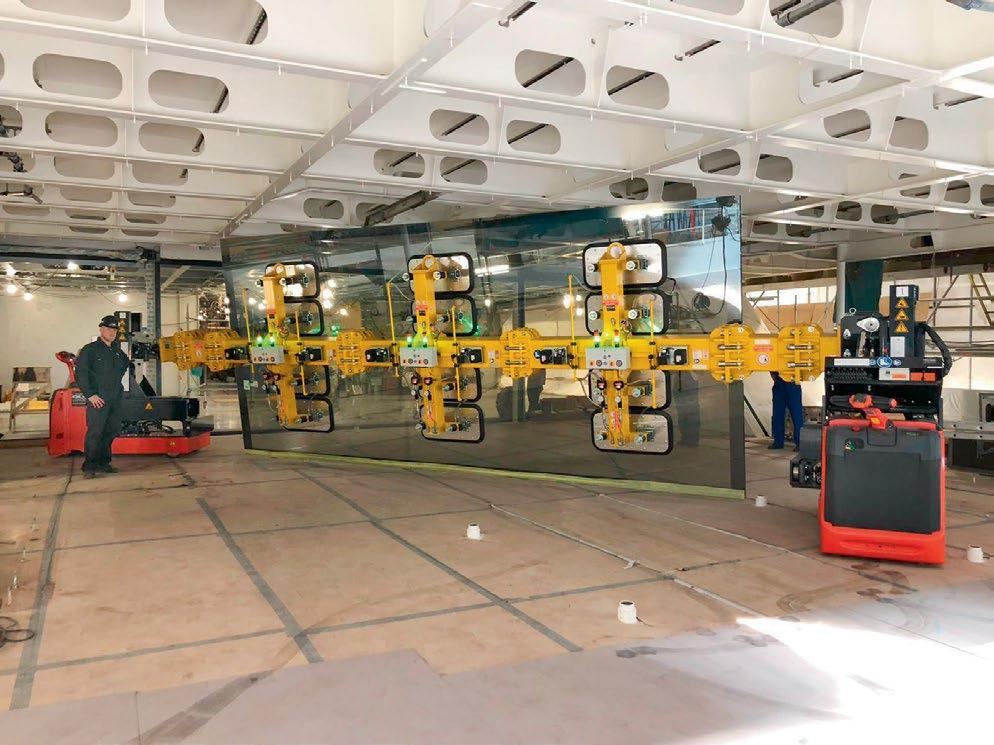


The Argo 54 has been teasing sailing superyacht fans since the project started back in 2020. As the 54-metre sloop begins the push toward completion at Omikron Yachts in Greece, we take a closer look at how the powerful yet lightweight aluminium project with sustainable sailing technology is coming together.
BY CHARLOTTE THOMAS
With its distinctive reverse bow and aggressive wedge-shaped hull, the Argo 54 sailing yacht presents a striking picture. A combination of Juan Kouyoumdjian’s raceboat sensibilities, the aesthetics and engineering nous of superyacht-savvy Rob Doyle Design, and the interior design skills of Mark Whiteley, the project pushes boundaries in terms of styling, naval architecture, structural design, and systems technology.
The idea sprang from the owner’s desire to create a modern, lightweight sailing superyacht that would be capable of fast cruising with guests and core crew, as well as racing with expanded crew and a bigger wardrobe of sails. The yacht would also feature a diesel-electric drivetrain that included a battery bank fed by renewables – hydro-generation in particular. The owner (who owns the shipping company that comprises Olympic Marine, the parent company of Omikron Yachts, and who was also behind the conversion of the 106.5-metre motor yacht Dream) tapped Kouyoumdjian to tackle the naval architecture and sailing elements in what is the designer’s largest project to date.
“The main brief was to design and engineer a superyacht that would be very well-balanced in breezes from five to 50 knots, and which would deliver a very pleasant experience from the helm,” begins Philippe Oulhen, design coordinator for Omikron Yachts. “The yacht was to have an owner suite and four guest suites, plus accommodation for seven to eight crew. She would run in both cruising mode – with a cruising sail set and reduced heel angles – and racing mode, with more crew, a bigger sail wardrobe, and a lighter displacement thanks to removing cruising gear, tender and deck furniture.”
With the Juan Yacht Design team creating the hull lines, the Rob Doyle Design team was brought in to style the yacht and look at the structural engineering to create as light a displacement yacht as possible. Their studies showed that they could build the hull in aluminium for less than a carbon structure and with more flexibility and volume for internal arrangements. In addition, stripping out unnecessary weight and systems became a focus of the project.
“We didn’t want to re-invent the wheel – it was important to use systems and equipment that are available on the market with a track record.”



The yacht’s lines include a reverse bow and lengthy forefoot overhang, a wide, low stern with a wine-glass shaped aft canoe body, and a centreboard-style swing keel. The hull also has a degree of tumblehome to take advantage of wider beam without increasing deck windage.
“The hull shape was optimised with our inhouse CFD cluster and know-how, with our method of feeding our velocity prediction program with 6DoF (six degrees of freedom) simulations covering wide true wind speeds and angles,” says Oulhen. “The stern bustle adds volume aft while the keel is up – when the longitudinal centre of gravity moves back – and the yacht’s stability and fore-aft trim at anchor will be controlled by this aft bustle and forward water ballast.”
The yacht features several design innovations, including the centreboard keel design (see sidebar) and a force-feedback system for the helms. “The novel steering system is an important part of the build,” says Nikolas Dendrinos, chairman of Omikron Yachts. “A standard hydraulic system doesn’t deliver ‘feel’, but it’s hard to sail fast if you don't understand the loads and what is happening with the rudder.”
Omikron opted for a system comprising two mechatronic actuators on the rudders that monitor loading, with the data sent via electrical signal to the helm to be translated into real-time force feedback. “It's similar to the fly-by-wire system on modern cars,” Dendrinos says. “For us this was very important to create the feel of a smaller boat – it will be very fast, very responsive, with twin balanced rudders.”
While the project features some technological leaps and involved in-depth FEA (see sidebar), most aspects of the design have been kept to tried and tested solutions.
“We didn't want to re-invent the wheel – it was important to use systems and equipment that are available on the market with a track record,” confirms Oulhen.
“The project is a nice coordination of good solutions working well together, with a prime example being the keel – the concept existed, but we refined it with all the partners. The same is true for the steering system, which tackles a major feature of the brief for the sailing. It’s proven fly-bywire technology that is well-implemented.”
Rather than opting for a big main engine with a PTO and a couple of generators, the design relies on a diesel-electric drivetrain with two full variable-speed generators that feed into a DC bus system and then into a 540 kilowatt-hour battery bank.
“It means you can run the entire system off the grid, and get a quiet ship,” says Rob Doyle, principal of the Rob Doyle Design studio. “The generators can be smaller and can be run at optimum load.”
At its core is an 800-volt DC bus with the batteries able to deliver between seven and 24 hours silent sailing and anchoring depending on loads, and with the gensets charging the batteries in one and a half hours. The yacht uses a special water-cooling system for the motors and drives in order to keep the system small and light.
“The chillers are also designed for energy recovery and efficiency,” adds Omikron Yachts head of design, Filippos Stratakis.
“There are five chiller units that ramp up in sequence according to demand, rather than having one big chiller unit that’s on all the time. The heat from the air-con system and generators is recycled, and the whole system delivers efficiency improvements of 25 to 40 per cent, and up to 75 per cent under some conditions. We did this to reduce the batteries needed for the hotel load and therefore reduce the weight, and we can also operate the hydraulic sailing systems and winches without running a generator.”
In addition to the generators, power will come from hydro-generation while sailing via a retractable aluminium shaft drive, which the design team worked on with Ship Motion.
“We basically wanted maximum blade area for hydro-generation with the prop running in reverse,” says Doyle. “Their prop guys did some research and designed an optimised propeller for maximum generation while sailing. It was the first step on the ladder of the technology that we’re already integrating into other boats, which is allowing them to do a full transatlantic without running a generator.”
With the Argo designed to start sailing in as little as four knots of breeze, and with hydrogeneration really kicking in above eight knots of boat speed, projections are the system will produce up to 55 kilowatts. However, the yacht is designed to sail in heavier airs too.

“In Greece we have very strong winds compared to the Med as a whole,” says Vassilis Kouvaris, Omikron Yachts’ project manager for the Argo 54. “We can go from zero to 50 knots, and 30 knots is very normal – these are no-go conditions for sailing superyachts, but this boat has been designed to sail in them easily.”

The Argo 54 uses a centreboard swing keel design built by Italian specialist keel-builder APM Keels. It has a ram mounted on the front side of the mechanism to pull the keel down and push it back up. An additional lock-step design in the keel box ensures that the keel is self-supporting when in the raised position, meaning the ram can be disengaged and removed if necessary.
“With all the big boats we’ve done the biggest problem we have is always dealing with the fuse and the grounding load, followed by the difficulty in undertaking standard maintenance on the mechanism,” says Doyle. The team designed a new type of fuse, so if the yacht grounds with the keel down, the will fuse break and the keel will pull away from the hydraulic ram, meaning the shock loads don’t get transferred to the rig, chainplates or keel box.
“It also means you don’t get ram compression, you don’t damage the seals, and you don’t get atomised hydraulic oil in the technical space,” adds Doyle. “It also allows you to re-engage the ram and push the keel up over the lock so it’s locked in the raised position, then you can back off the ram, change the fuse, re-engage the ram, bolt it all back together and you’re good to go – there’s no need to get to a dry dock.”


Hull fabrication was done at the Gouwerok Shipyard in the Netherlands and was completed in November 2022. “They are one of the best aluminium builders in the world,” enthuses Doyle. “In their contract they guaranteed a maximum deflection of three millimetres concave over six metres, with zero convex. It was like an aircraft fuselage – you could have polished it and sent it out the door.” A notable feature is that the hull doesn’t have a standard frame size, each one being designed for the load case. FEA was used to optimise the scantlings by playing with different frame spacing and longitudinal structure to see which models yielded the lightest weight. This has had other interesting impacts: by concentrating the major forces from rigging and keel through three key reinforced frames, the team was able to reduce the amount of structure required for the deck. Indeed, the turnbuckles for the shrouds are in the engine room, a result of the chainplates being located in the turn of the bilge. The mast itself comes from Southern Spars and is deck-stepped, supported by Aerosix rigging.


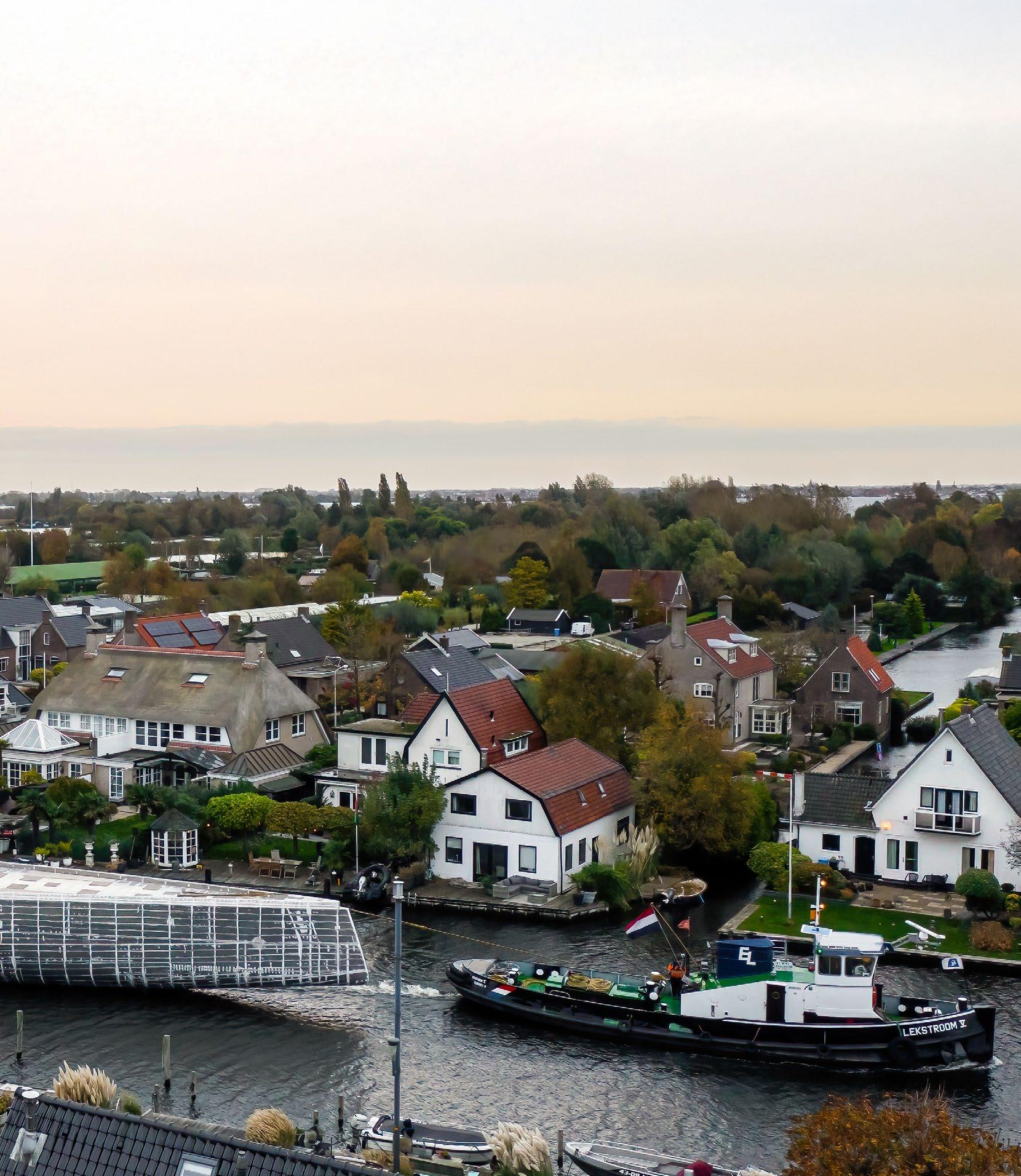
“Gouwerok in the Netherlands is one of the best aluminium builders in the world. It was like an aircraft fuselage – you could have polished it and sent it out the door.”
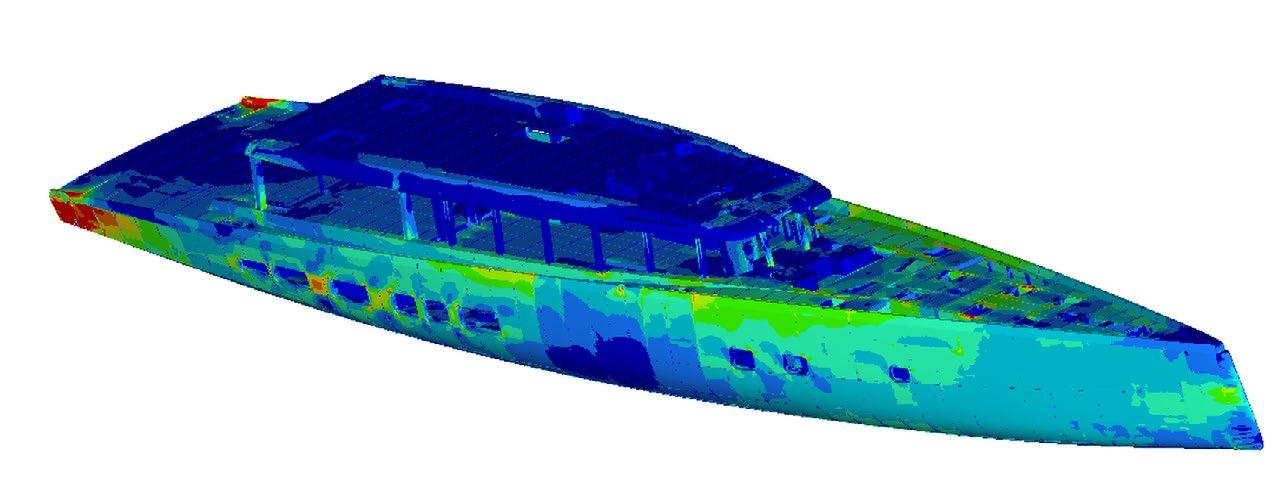
At the project’s core is a carefully engineered and beautifully constructed aluminium hull and deck weighing just 62 tonnes, which according to Dendrinos makes the Argo 54 the lightest aluminium hull ever built for its length, saving around 35 tonnes of aluminium compared to a standard build. The engineering required the Doyle team to delve deep into the rules in order to keep the structure as light as possible while still meeting class requirements.
“We approached the structure from first principles, while also considering the differences in class rules – a Lloyd’s boat wouldn’t fit under DNV, for example, and a DNV boat wouldn’t fit under an ABS programme,” says Doyle. “But it was a fantastic bit of research, because it showed that if you push the meaning of each rule to its limits they all come out about the same, with weight within a couple of percentage points of each other.”
With the shipyard choosing to build
to Bureau Veritas came an interesting conundrum when the surveyor said that the size of the frames needed to be doubled. In order to keep their lightweight design, the team did full finite element analysis (FEA) to prove every part of the hull’s structure was sound. This had an additional benefit: “We discovered that a historic phenomenon with plating distortion around the chainplates wasn’t due to the aspect ratio of plates, as had previously been thought, but was from the stresses running around the turn of the bilge and creasing the boat – something that only detailed FEA could show,” explains Doyle. “We ended up beefing up the plating around the structure of the hull where the chainplates are located way more than what the rule specified, and we were then able to go back to class and point out the problem, and recommend they upgrade their rules.”

A notable feature is that the hull doesn’t have a standard frame size, each one being designed for the load case.

Previous spread:
Below: At the time of our visit major
Sitting in a vast shed at the Skaramangas shipyard near Athens, much of the hotwork has been completed and the hull has been faired. The project has been making slow but steady progress since the hull arrived in Greece at the end of 2022, but the team has also been waiting for technology to catch up – in particular in relation to the DC grid system, which is being engineered by Baumüller, a German company specialising in systems for commercial shipping.
Work will soon start engineering the interiors and building mock-ups at Olympic Marine to confirm cabin layouts, crew areas and other details before ordering in the materials for the production of the interiors proper. The interiors, which will feature lightweight Nomex core construction, will be built at Olympic Marine in parallel with progress on the technical fit-out at the Skaramangas yard. Dendrinos estimates a further 18 months of build time before the yacht is launched.
The owner and crew will be making good use of that time. Because of the performance nature of the hull and the sail plan, the yard has bought a Volvo 70 (also designed by the Juan Yacht Design studio) from the 2012 edition of the Volvo Ocean Race for the crew and owner to train on.
“Sailing at these kinds of speeds is a different mentality, and we will also step to a hydraulic system on the 70 similar to what the Argo will have,” says Dendrinos. “If you have infinite power to control your sails, it becomes more complicated because you can’t feel the loads. The training is also key to ensuring the owner won’t need a large crew of professional racers to enjoy the yacht – he wants to sail with his friends.” For all the convention-defying aspects of the Argo 54, that aspect at least, it seems, is convention to its core.
















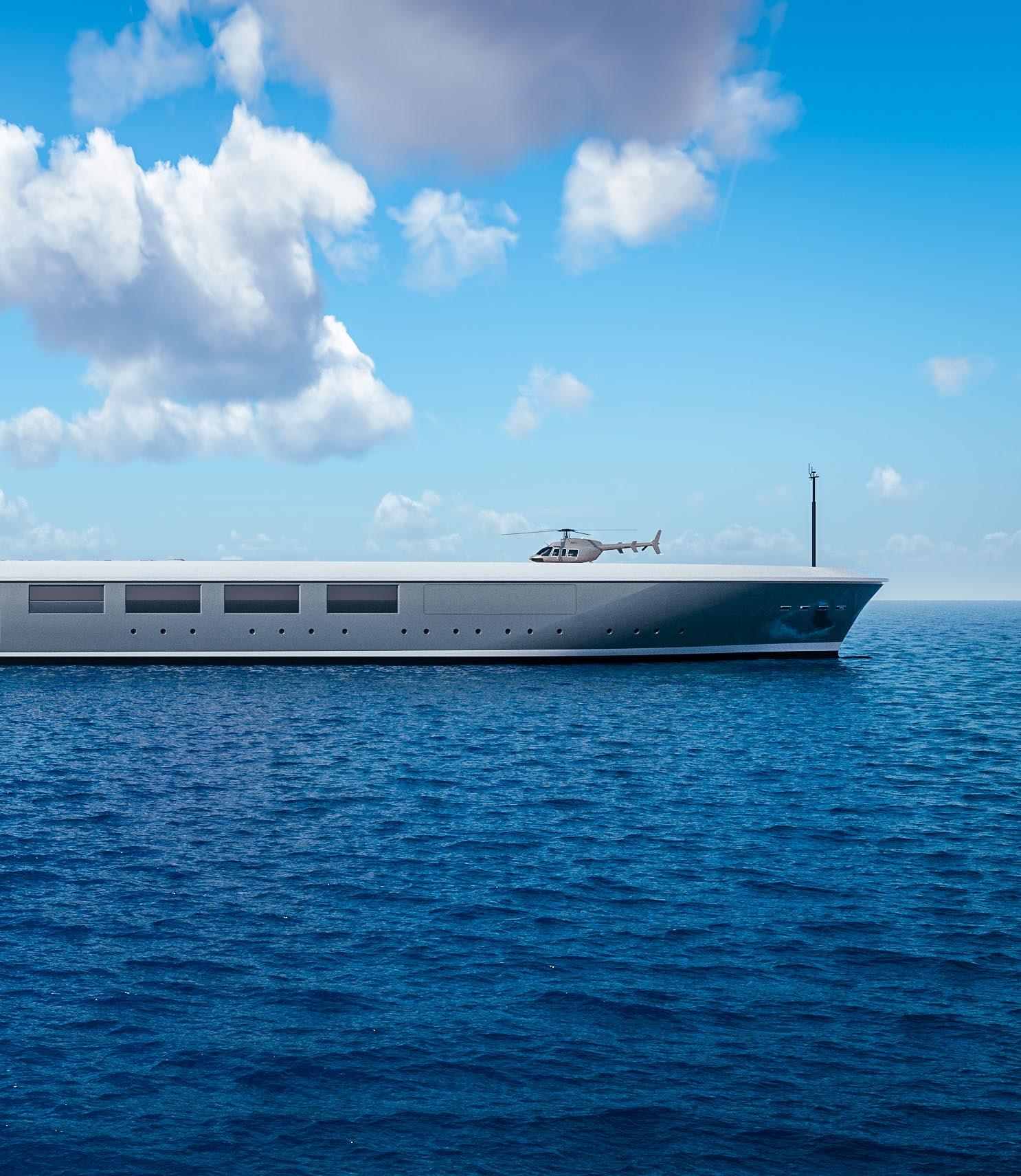
All sorts of working vessels, from ocean-going tugs and fishing boats to ice breakers and naval vessels, have been converted into superyachts. But not a container ship – at least not yet. Doing so requires rethinking every aspect of a ship designed exclusively for carrying cargo. That didn’t dissuade Oceanco from teaming up with Italian yacht designer Mario Biferali to develop Anthos.
BY JUSTIN RATCLIFFE
Conversion means razing the entire internal structure down to the double bottom and rebuilding it.
Mario Biferali was first drawn to the idea of naval regeneration while researching his PhD thesis that analysed the evolution and increasing size of yachts over the decades. Blending the words ‘naval’ and ‘yacht’, he coined the term Nacht to describe the process of breathing new life into a container vessel by transforming it into a luxury yacht. Having previously worked with Oceanco as an engineer on several new-build projects, including the 109-metre Bravo Eugenia, Biferali approached the Dutch builder to explore the idea further. The result was Anthos, a 150-metre concept first presented at last year’s Monaco Yacht Show and based on the complete rebuild of a container ship.
“Mario’s technical background means that he’s not given to fluffy thinking,” says Wim Verhoeff, sales director at Oceanco. “When he sent the initial general arrangement it was already pretty much spot on with regard to watertight integrity, fire zones, allocated space for HVAC systems, and so on. Our job was to make sure it could be built.”
The core idea behind Anthos – to leverage the high volume of a commercial hull while introducing an entirely new internal architecture and a forward-thinking approach to propulsion and comfort – aligns with Oceanco’s Life Cycle Support initiative, which aims to give existing vessels a new lease of life. Unlike conventional conversions of decommissioned or aging support ships, Anthos begins with a structurally sound, operational container vessel. This reduces material waste and conversion costs, while still offering a faster timeline compared to new builds.

Still, the donor vessel’s condition is obviously critical and the team has shortlisted a dozen or 1990s-era container ships with a gross tonnage around 12,000 GT – a volume expected to increase post-redesign. For example, 150-metre Meratus Mamiri (IMO 9106649) was built in 1995 and has a volume of 11,964GT, and MSC Belle (IMO 9203904) is a 148-metre vessel of 12,004GT launched in 1998. Both have a beam of 23 metres. Though service life varies, vessels such as these are often retired due to market forces rather than physical wear and tear.
“Maritime transport is cyclical and tied to global trade,” Biferali explains. “During downturns, shipowners face oversized fleets. When that happens, some vessels are sold off, others are scrapped, but many remain in good operational condition despite being commercially obsolete.”


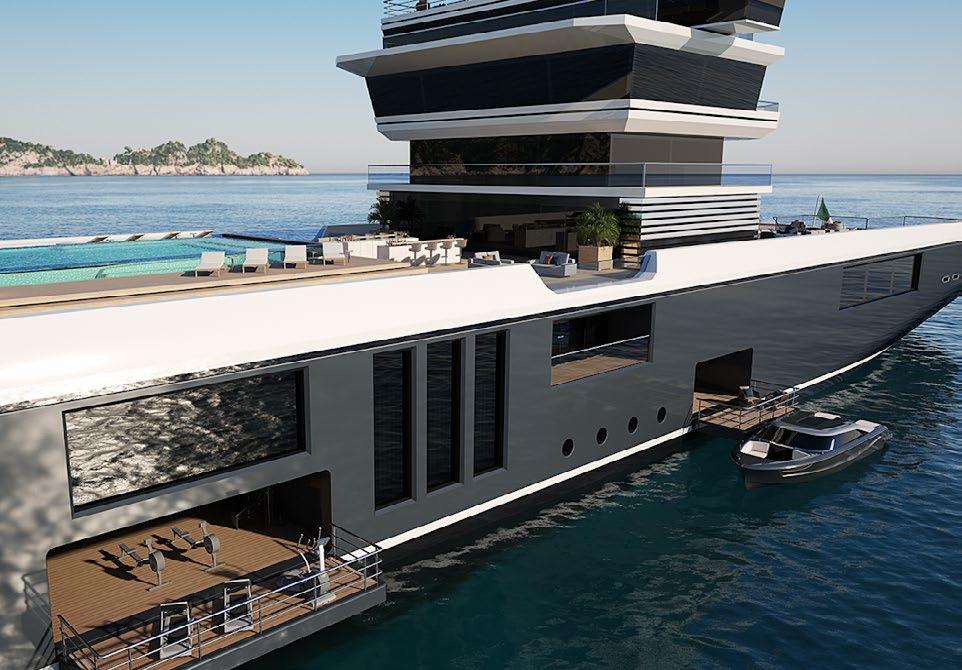
From a technical design perspective, the concept poses both opportunities and challenges. The hull of a container ship compared with that of a bulk carrier or an oil tanker has a finer, more hydrodynamic form designed for low-resistance cruising, which is not dissimilar to large yachts. This is reflected in their block coefficient – the ratio of a vessel’s displacement to that of an equivalent cuboid, which essentially defines the ‘fullness’ or ‘fineness’ of the hull shape. Expressed as a value from 0 to 1, a container hull has a block coefficient between 0.6-0.7, compared to 0.80.9 for fuller-form cargo vessels, and 0.5-0.6 for fast naval corvettes or frigates.
The beam of a 150-metre container ship aligns with that of a conventional superyacht of similar length, but fully laden the draft can draw 8-9 metres. This is why container ships rely on various ballast systems to maintain stability when unladen or in port. For yachts up to 90 metres in length, Oceanco avoids ballast tanks in order to prioritise the luxury areas and minimise the complexity of onboard systems, but over 100 metres some form of ballast is desirable to maintain trim and compensate for fuel or water consumption during longer voyages. As Anthos would already have a built-in ballast system, Oceanco would balance weight distribution and optimal draft with system upcycling and sustainability considerations. “Partial or full reuse of ballast systems is ideal to lower the carbon footprint associated with new construction or system overhauls – if compatible with the new yacht’s operational needs,” says Verhoeff. “ To enhance onboard comfort further we would also include an active underway stabilisation system.”
Structurally speaking, the conversion would be substantial. Container ships are designed and built very differently to yachts. They have no continuous main deck running the full breadth of the ship, for example, and fewer transverse bulkheads. Instead, they are made up of several holds with deck hatches and each hold is equipped with “cell guides” that allow the containers to slot into place. Conversion means razing the entire internal structure down to the double bottom and rebuilding it, removing the deck hatches and adding an extra tier to the hull topsides, as seen in the renders of Anthos Moreover, in conventional yachts the superstructure bulkheads are usually aligned with the watertight subdivisions in the hull. Here again Anthos departs from the norm as the superstructure is comprised entirely of the owner’s ‘tower’ spanning 284 squaremetres over three decks with lounges, offices, a media room, and 298 square-metres of terraces, including a private sundeck above the wheelhouse. Anthos’ hull accommodates two full decks and an under-lower deck for technical equipment, tankage and crew support functions. Installing new decks in former cargo holds would require extensive steelwork, along with floating floors, noise isolation, and flexible machinery mounts. The guest accommodation – including two double-height super VIPs – is housed on the guest lower deck. The leisure lower deck contains expansive social spaces such as port and starboard side ‘Sea Gardens’ with vertical green wall, a full-beam terrace overlooking the stern, full-beam gym, wellness zone, double-height sports court, and a cinema room. Many areas are modular, allowing repurposing for scientific research or philanthropic activities. In the fore section are 27 cabins for 54 crew members.
Biferali began planning for HVAC, cable routing, technical spaces and insulation early in the design process, but circulation flow was a particular challenge in the long, narrow hull. The solution is multiple points of vertical access along the length of the hull to minimise travel distance for guests. The crew have dedicated routes to maintain operational efficiency without infringing on the guest zones.


A central question emerged: just how much structural modification can a hull of this scale tolerate?



Considering the many hull perforations envisaged for panoramic windows and folding platforms or balconies, including a 14-metre long aperture for the tender bay and a 19-metre swimming pool amidships on the top deck, a central question emerged: just how much structural modification can a hull of this scale tolerate? The original double bottom and box-like arrangement of wing tanks, also used for ballast, provide longitudinal strength, as would the extra steel plating for the redesigned hull topsides, while new bulkheads would add transverse strength. Full FEM analysis would be required to verify the resilience of the final structure. The scale of Anthos means it can accommodate Oceanco’s Energy Transition Platform (ETP) – a modular energy architecture developed in collaboration with Lateral Naval Architects that enables a future-proofed path to zero emissions. Designed for staged retrofitting, the ETP can accommodate new configurations and specifications to integrate future technologies
and alternative fuels as they come online.
“We know that in the coming years we will see a lot of changes when it comes to alternative fuels, so we want to be prepared for that energy transition,” says Verhoeff.
The donor ship’s medium- or slow-speed engines could be upgraded or replaced with a dual-fuel methanol system, for example, which seems to be the most plausible interim solution for yachting. However, because methanol is less energy dense than diesel, it requires roughly 2.5 times more storage volume. A container hull has the space for more tankage, which a regular superyacht does not.
“Time saved – rather than cost – is usually the main advantage of conversion over building new,” Verhoeff concludes. “While a new 150-metre build might take up to five years, a conversion can cut 12 to 24 months from the schedule. For many owners, this time advantage is more valuable than cost efficiency, particularly in a market where demand for larger, bespoke vessels is high and availability is low.”

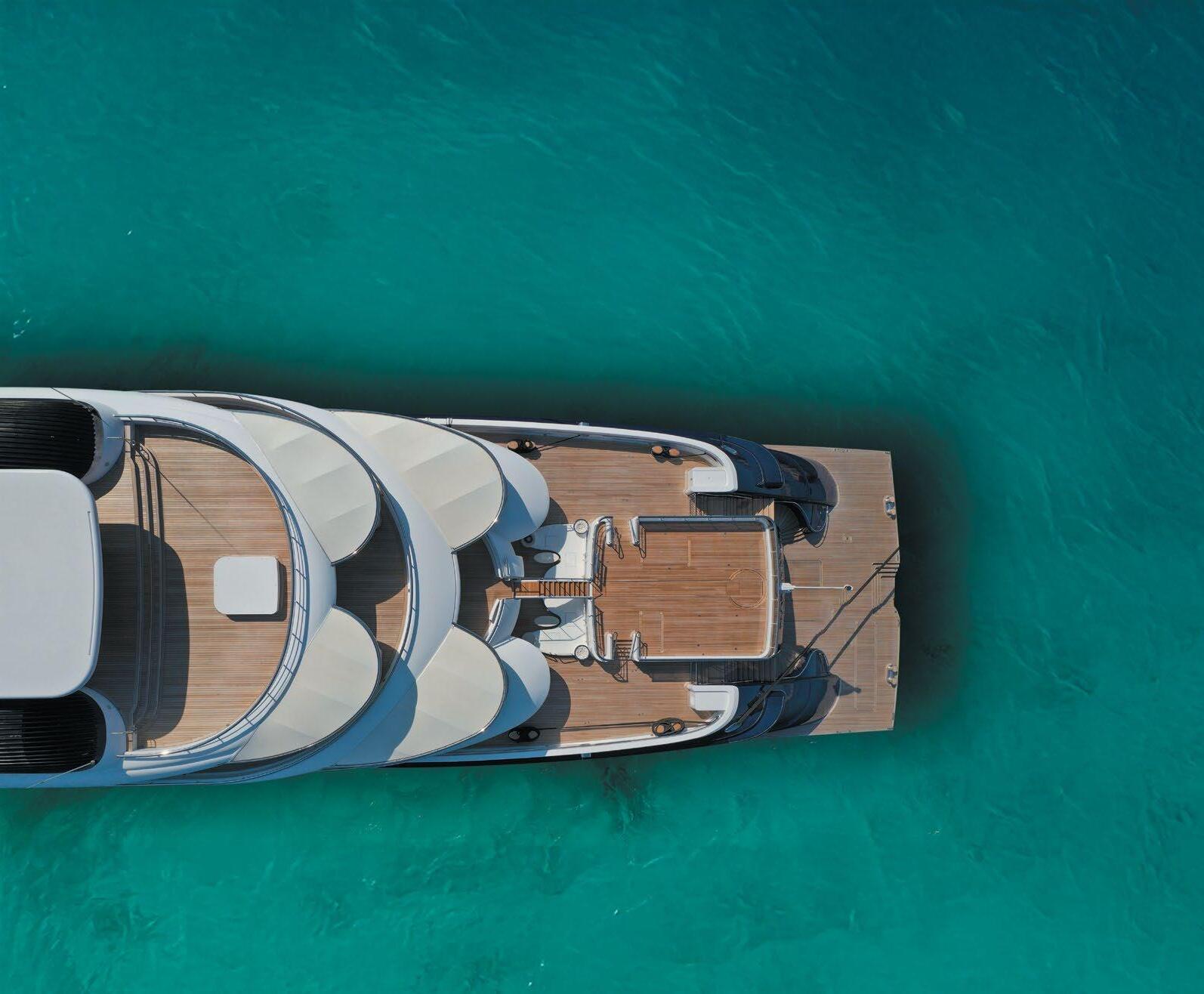
In the world of superyacht construction, precision is key. Since 1962, Blokland has partnered with leading shipyards to deliver high-end propulsion systems for motor and sailing yachts – build to meet the highest standards of performance, comfort, and reliability at sea. Our complete propulsion and rudder systems are engineered in-house, ensuring full control over quality, fit, and seamless integration into each unique build.
Blokland propulsion systems are trusted by some of the world’s most respected superyacht builders. Why? Because they know we don’t just supply components— we deliver peace of mind. Our systems are built to perform, built to last, and built to exceed expectations.
Whether you’re building a 40-metre explorer or a 70-metre flagship, we’re ready to support your team with propulsion systems that match the ambition of your project. Let’s keep moving forward, together.





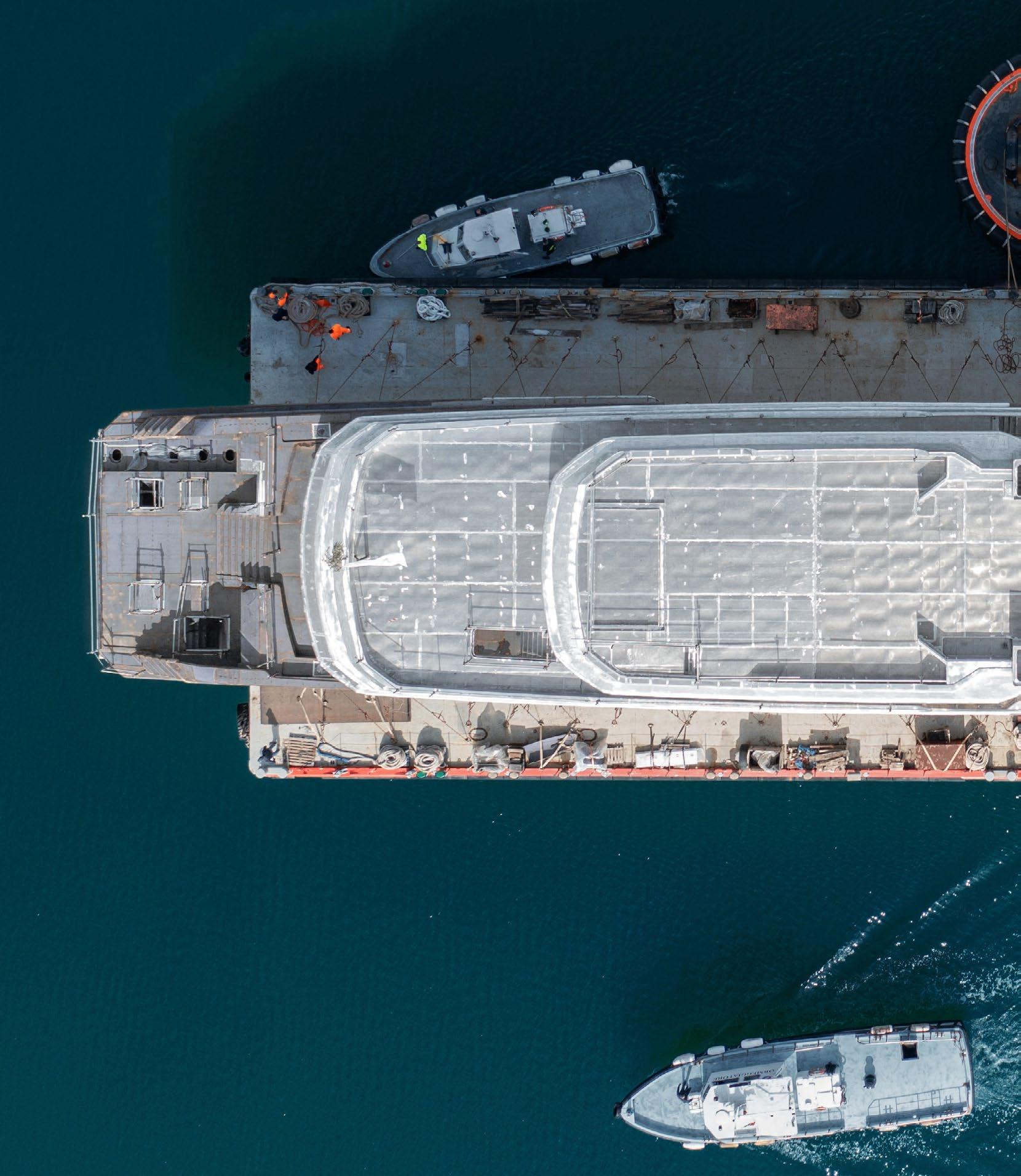

With Project Thunderball, CRN in Italy has ventured beyond its custom culture by collaborating extensively with northern European subcontractors – an uncommon move for any Italian shipyard that typically rely on a wellestablished network of domestic suppliers. Beginning with Vripack for the exterior design and preliminary naval architecture, this shift has pushed technical boundaries and blended contrasting management styles.
BY JUSTIN RATCLIFFE

“We began discussions with the owner in the summer of 2018,” recalls Marnix Hoekstra, co-creative director at Vripack. “The dimensions evolved based on how he planned to use the yacht with his family. Initially, it was for global cruising, so we had one extra deck. At one stage we scaled down to around 50 metres or 500 gross tons, then scaled back up and tank tested a 66-metre model. Ultimately, the project was locked in at 70 metres and 1,100GT.”
Despite the fluctuations in size, several key priorities emerged early on. One was a clean yet classic styling inspired by The One (ex- Carinthia VI designed by Jon Bannenberg). Another was a modest draft as the yacht will spend considerable time cruising the Bahamas. A third was foredeck storage for large tenders – including a 9-metre military-spec Hurricane – where cleats built into the scuppers also allow for mooring a large sailing yacht. The owner further requested a generous aft platform for watersports and chase boat access and, in a late request, asked for a built-in plunge pool.
Y.CO was involved from the outset, managing the bidding and tender process on the owner’s behalf. CRN was selected after a thorough evaluation of technical capabilities, project fit, and past performance. Y.CO had previously collaborated with CRN on a Riva 50 and was impressed by how well the yacht performed after a full cruising season in terms of build quality, engineering reliability, and systems integration – all of which aligned well with the specific demands of Project Thunderball. Given it had largely been built speculatively, the yacht served as reflection of CRN’s in-house standards.
“That said, this custom project is definitely something new compared to what we typically build,” notes Filippo Belcecchi, Engineering Manager at CRN and Ferretti Group Superyachts Division. “CRN took over responsibility for the naval architecture from Vripack at the time of contract signing and refined the hull shape slightly to make it simpler to build. But the bespoke nature of the project is also reflected in the choice of suppliers, which in several cases are Dutch rather than Italian, as per the client’s requests.”



Below: Y.CO technical representative Patrick Foy is particularly impressed by the
It is well known that shipyards – wherever they are based – tend to stick with local or national suppliers. It simplifies logistics, ensures smoother communication, leverages familiar supply chains, and yards are familiar with local supply chains that speak the same language. However, the owner’s team favoured a hybrid sourcing approach, blending Italian and northern European suppliers to ensure the best equipment was selected for each task.
That strategy is visible throughout the yacht. The deck crane is from Van Driel, the transom shell doors from Newthex, the jacuzzis from Seable & Co, and the sliding doors and windbreaks from RM Nautical (although the glass itself is by Italy’s Viraver). These, and others, are all top-tier Dutch brands chosen not only for their high-quality hardware, but also for clear communication, strong planning, and reliable engineering support. Rather than simply opting for premium pricing, the team spent strategically to deliver maximum value for the owner.
Take the wheelhouse, for example. Many superyachts now feature ‘glass bridge’ consoles, where navigation and comms systems are hidden behind a seamless foil surface. Northern European yards often use a single foil panel – a costly solution that also complicates repairs or replacements, since the entire foil and substructure must be removed.
Thunderball ’s bridge uses individual foil panels that achieve the same minimalist look but are much easier to access. Y.CO’s technical representative Patrick Foy calls it common sense: “Why spend extra money on something that’s just going to cost you more down the line?”


The owner requested high-fidelity audio throughout the yacht with minimal levels of distortion and a full range of audible frequencies. However the audio hardware, including speakers and subwoofers, had to be virtually invisible. UK-based Icon Connect, specialists in designing custom AV solutions, was contracted to come up with efficient and stylish solutions.
For the guest cabins, K-Array speakers were selected. Made in Florence, Italy, the Vyper-KV102R II is a passive line array speaker that is one metre tall but only 50mm wide and 37mm deep. Comprising 16 neodymium magnet transducers housed in an invisible and resistant aluminium chassis designed for in-wall, recessed installations, it could all but disappear into the wall panels. Positioning speakers for best effect is a science in itself and the tall KV102 further means it can be placed at head height for even coverage and optimal reception by the human ear.
“Although K-Array offers a wide variety of standard finishes, they did not have a match close enough to the colour of the inlays,” says Dave Allum, Technical Manager at Icon Connect. “We worked with the interior designers at Nauta Design, the furniture fabricator and K-Array to have the speakers finished in the exact same material and colour as the paneling.”
The speakers were coupled with K-Array Rumble subwoofers, which are being installed behind custom micro-drilled panels. The main saloon uses the same speakers in the same finish, but installed in the window mullions.
In the master stateroom Icon Connect specified 10 Wisdom ICS3 speakers, an in-ceiling solution designed to provide high-resolution playback and even stereo audio coverage from small (75mm) apertures. These speakers also have colour matched grilles to match the ceiling fabric.
On the open aft decks James PowerPipe subwoofers supported by custom James OW23-M speakers are integrated into the fixed furniture in the exterior social areas by Nauta Design. Together with James, Icon Connect investigated making the speakers with curved grilles to match the curve of the metal seating, but it was deemed more technically viable to have rectangular recesses built into the bench seats and use the same micro-drilling technique used in the guest cabins to create the grilles.

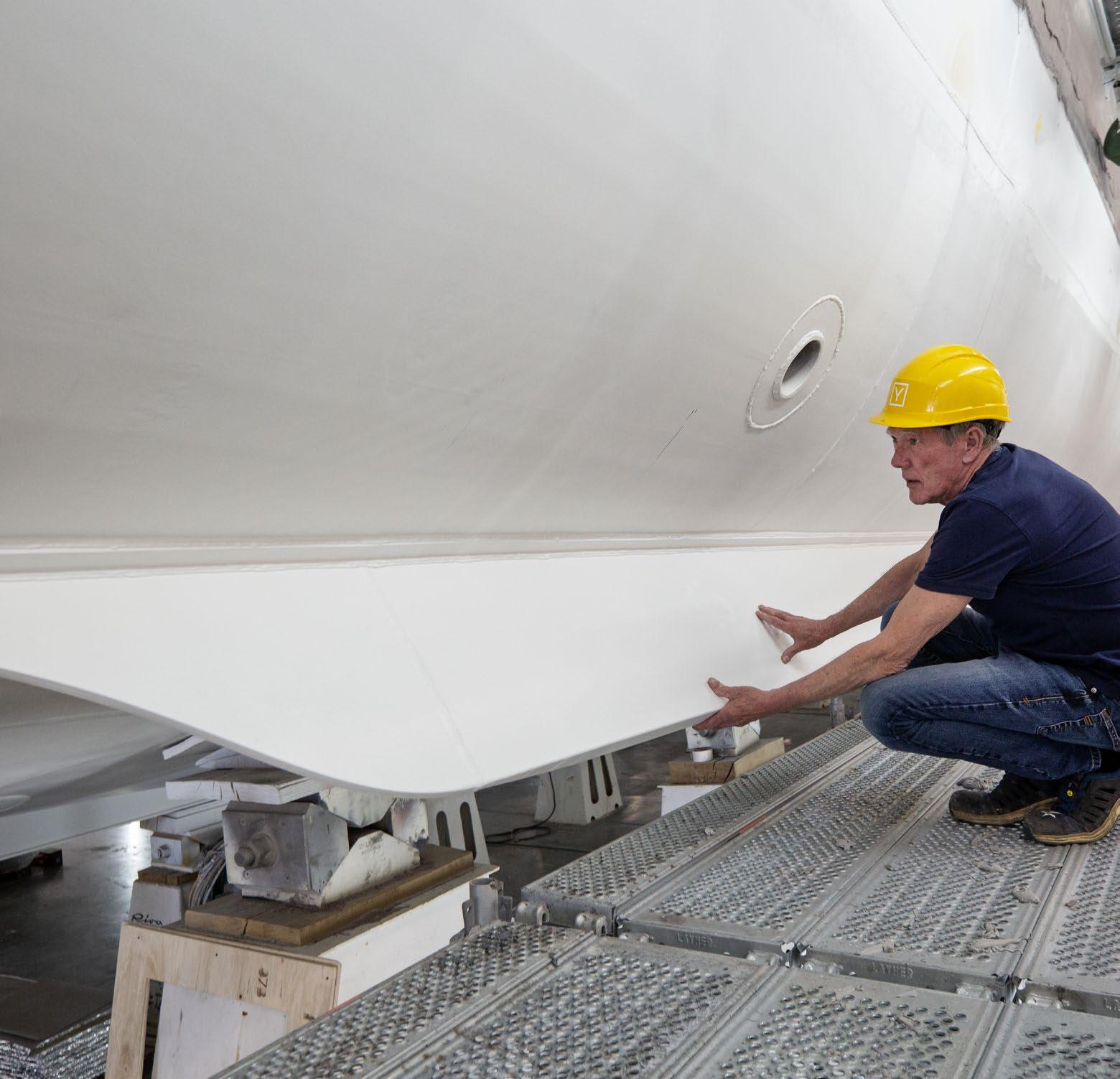
“Bringing northern subcontractors into the fold has added value, no question. But it also made things more complex.”

“Bringing northern subcontractors into the fold has added value, no question,” says Belcecchi. “But it also made things more complex. We had to adapt our way of working to different communication and management styles.”
Belcecchi explains that Italian yards usually begin steel-cutting before the engineering phase is complete, enabling design tweaks during the build and shortening delivery time. Dutch and German yards, by contrast, finalise all technical documentation before construction begins –leading to more predictable schedules but less mid-build flexibility. The Italian approach can reduce time to delivery, but inevitably involves more risk.
“I have to say CRN didn’t shy away from the challenge,” says Y.CO project coordinator Umberto De Vido. “They bridged the gap through proactive communication and transparent documentation. This adaptability enabled us to integrate high-spec equipment from suppliers who usually operate with longer lead times and stricter schedules.”
In addition to the exterior styling, Vripack developed the preliminary naval architecture, focusing on a sleek hull for efficiency and elegance. Once the contract was signed, CRN assumed responsibility for the technical design, introducing adjustments to simplify fabrication and enhance seakeeping. As with all CRN projects, the steel hull was constructed by CPN in Marghera, Venice, and delivered to Ancona by barge. Although CPN is Italian, the build crew was mainly Croatian – praised by Patrick Foy for producing “one of the best hulls I’ve ever seen”, outperforming northern competitors who build in Poland or Romania.
“The hull’s slender form was very efficient, but is more prone to rolling,” Foy explains. “So the team added bilge keels – a low-tech yet proven solution –to reduce roll amplitude without relying entirely on the Quantum rack-and-pinion stabilisers. The bilge keels are 12 metres long and 400 millimetres deep, reducing the need to activate the stabilisers in light seas. That means less wear and lower maintenance costs.”
Another technical highlight is the energy storage system: 800kWh of Dolphin NxtGen batteries by Norway’s Corvus Energy, who also supplied the batteries for the 79-metre Feadship Valor. Housed in a fire-rated A60 compartment on the under-lower deck, the modular batteries handle peak shaving and silent anchoring. Lightweight and highdensity, they’re designed for rapid charging and flexible layout. The catch? At the time of specification, the system hadn’t received Lloyd’s Type Approval. CRN worked closely with Corvus and the classification society to ensure integration and compliance.
The owner also had strong preferences regarding noise and odours. “He didn’t want to hear auxiliary exhaust or smell food from the galley,” says De Vido. “The solution was to route exhaust from not only the generators but also the galley, through the mast. “It wasn’t easy to find space for the extra ducting, but the guest experience will be better for it.”


Facing

Despite its 70-metre length and four full decks plus a half-height under-lower deck, Project Thunderball is a relatively lean 1,100GT – reflecting its classically inspired profile and the owner’s preference for outdoor living over internal volume. This required compromises: there’s no guest lift, for example, and the GA was adjusted to improve crew circulation while maintaining guest privacy.
Initially, there was no way for crew to move fore to aft on the bridge deck without passing through guest areas. That’s been fixed with a discrete interior corridor, enabling crew to move between mooring stations while remaining out of sight. “It’s about allowing crew to be everywhere, but invisible,” says the captain. The galley was also relocated from the lower to the main deck to shorten routes to dining areas. The vacated space now houses walk-in cold and dry stores. Vripack initially wanted them to retractable wing stations on the bridge deck to preserve the yacht’s vintage lines. But the cost and complexity wasn’t justified by the operational benefits, so fixed ‘blisters’ were added instead – retaining the look with fewer headaches.
“From an operational point of view, we made a few key changes,” the captain adds.
“There were some tough conversations as Vripack’s aesthetic vision – driven by the owner’s exacting eye – sometimes took precedence. He could spot a variation of a few centimetres in the sheerline. That level of visual commitment came at the expense of some practical considerations, which we helped balance.”
Walking through the yacht in build, the attention to detail is evident: to validate the painting quality, a mock-up of a section of hull and bulwark was put through the entire coating cycle, from fairing to gold cove stripe; cabling and piping is routed with clinical precision, usually a northern European hallmark; longer and wider drip trays are designed to also catch leaks at pipe junctions, and so on. “I’ve spent years working in northern European shipyards,” affirms Foy. “And when I walk through Project Thunderball, I ask myself – what’s missing? What could be done better? Honestly, nothing. It just works.”
Project Thunderball is a case study in cross-border collaboration. Along the way, there have been challenges – from exhaust routing and battery integration to late design requests – and further refinements can be expected as delivery approaches. Nevertheless, when the yacht is launched in spring 2026, she will stand as an example of how flexible project management combined with technical rigour can bring together the best of northern and southern Europe.

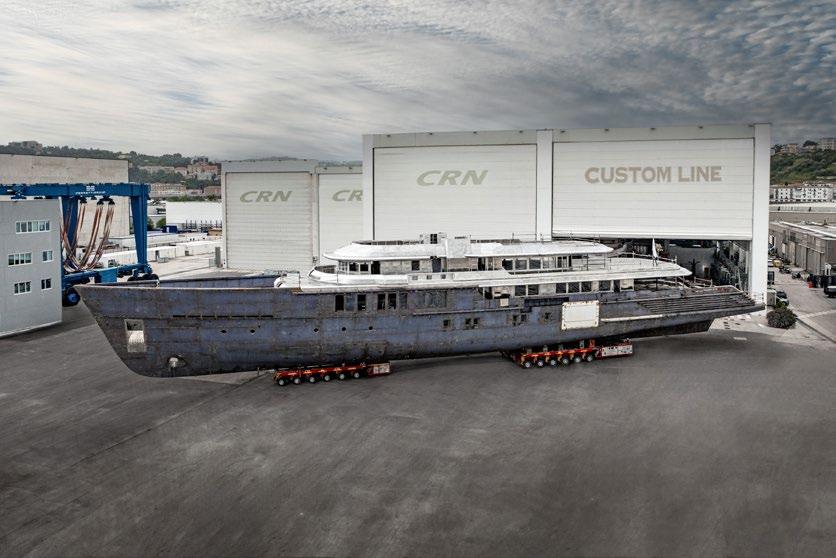


so many to choose from, so many to solve now available in a “connected” version


As part of an ongoing mission to meet the demand for integrated diesel and hybrid drive solutions that are both cleaner and smarter, the Power Systems division of Rolls-Royce is transforming its production of mtu engines by investing in cutting-edge manufacturing technology at its plants in southern Germany. We went to take a look.
BY JUSTIN RATCLIFFE
The first thing you notice when you walk into Rolls-Royce Power Systems’ stateof-the-art production facility in Kluftern near Lake Constance, is just how quiet it is. Known as Plant 4, this is where its high-speed mtu Series 2000 engines are assembled, mostly for the marine sector but also for powergen and mining applications. Stepping onto the shopfloor with Assembly Director Michael Fink, we’re able to talk normally without raising our voices –something I hadn’t expected, given the heavy machinery involved. He points out that the lack of noise is due in part to the electric tugger trains instead of forklifts for moving materials around the facility, and whisperquiet Automated Guided Vehicles (AGVs) that replace traditional conveyor belts for transporting engines and components along the assembly line.
“The self-driving AGVs are completely silent, but they also help speed up production by reducing bottlenecks,” Fink explains. “They even recharge themselves between stations to avoid unnecessary downtime and, unlike traditional production lines, the system allows for faster reconfiguration to accommodate different product specifications.”
The AGVs are part of an intelligent control system that optimises production efficiency while maintaining flexibility to scale up operations if needed. Further, the building has been designed to be as energy-efficient and climate-friendly as possible with a 1.2 MW-peak photovoltaic system producing green electricity and e-charging columns for clean mobility.




Rolls-Royce Power Systems, injection system supplier Woodward L’Orange and nonprofit research institute WTZ Roßlau began working on the joint MeOHmare project in 2023. Funded by the Federal Ministry of Economics and Climate Protection (BMWK) to the tune of €8 million, their aim was to develop a high-speed internal combustion engine (ICE) for marine use capable of running on green methanol (e-methanol). Green methanol has advantages over other e-fuels for mobile applications. A liquid fuel at ambient temperatures, reduced complexity and more attractive investment costs, are just some of the benefits that give it a leg up over pure electric propulsion and hydrogen-fuelled energy converters. While LNG has a higher volumetric density than methanol, for example, it requires more complex and costly engine technology, fuelling systems and cryogenic storage. However, methanol still requires 2.54 times more storage volume than conventional fuels and significant changes to the combustion engine concept. The MeOHmare ICE development focused on redesigning the whole combustion process, as well as all the engine subsystems, and Rolls-Royce Power Systems has fully tested a singlefuel solution. Market projections have since changed, however, and the expectation is that diesel will remain dominant for marine applications into the near future with dualfuel methanol as an interim technology.

The assembly begins at the Grundlinie or baseline, where the core components that form the heart of the engines –camshaft, crankshaft, cylinder heads, pistons, connecting rods – are assembled. Depending on cost-benefit analyses and the complexity of the tasks, some of these pre-assembly steps are performed manually and operators are periodically retrained to ensure they maintain a high qualification level. Intelligent, multi-spindle screwdrivers then secure the parts, ensuring that each is adjusted to the correct torque and providing real-time verification that each tightening operation meets the required standards. A sensor-guided turning station automatically lifts and rotates the crankcases for easier and safer assembly of the pre-assembled pistons and connecting rods.
In fact, safety and ergonomics were a priority when designing the facility. For example, the trolleys used to deliver components to the
assembly stations are precisely 13 centimetres higher than standard to avoid operators straining their backs when lifting out the parts (at the time of our visit, the workforce was about to be rewarded with a bonus for reaching 18 months without employee downtime due to work-related incidents.
Operators are supported by a Manufacturing Execution System (MES) that displays onscreen all the information they need and guides them through the correct sequence, showing the exact configuration of parts for each engine and assembly drawings. As the engines move along the production line, they pass through a series of quality gates where specific checks are performed. At each gate, a green light indicates that an engine has passed the checks and can move on to the next station. Suspended from the ceiling in the middle of the hall are four giant screens that relay progress – and possible hold-ups –at each stage of the production line.
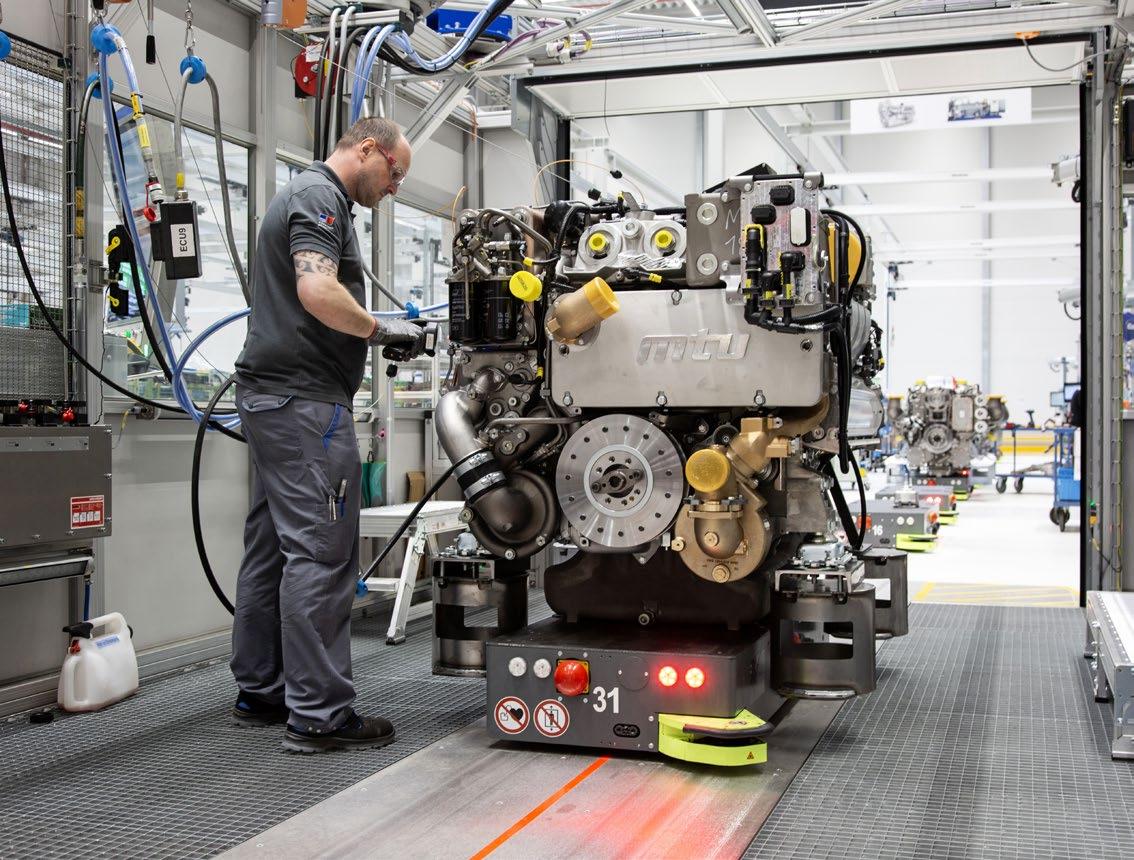
There are some 25,000 active mtu marine engines in operation, representing 17 million running hours per year.
“After completing the basic assembly, the engines enter a buffer zone according to final application,” explains Fink. “Marine engines are often specced to meet specific customer needs. This adds complexity, which means they take longer to assemble – up to three times more than a genset engine – so after the baseline assembly the marine units are routed to a dedicated line for custom configuration.”
Sensors are used to monitor the status of components and identify potential issues before they hold up production, but physical checks are also an essential part of the quality control process. For example, one of the last stages is a leak test whereby real fuel is pumped into the engine under pressure to ensure there is no leakage from the multitude of gaskets, bolts and screws. The engines then undergo a visual inspection at the final station, marked by a checkered finish line, before they are deemed ready for transport to Plant 2 for further evaluations and painting.
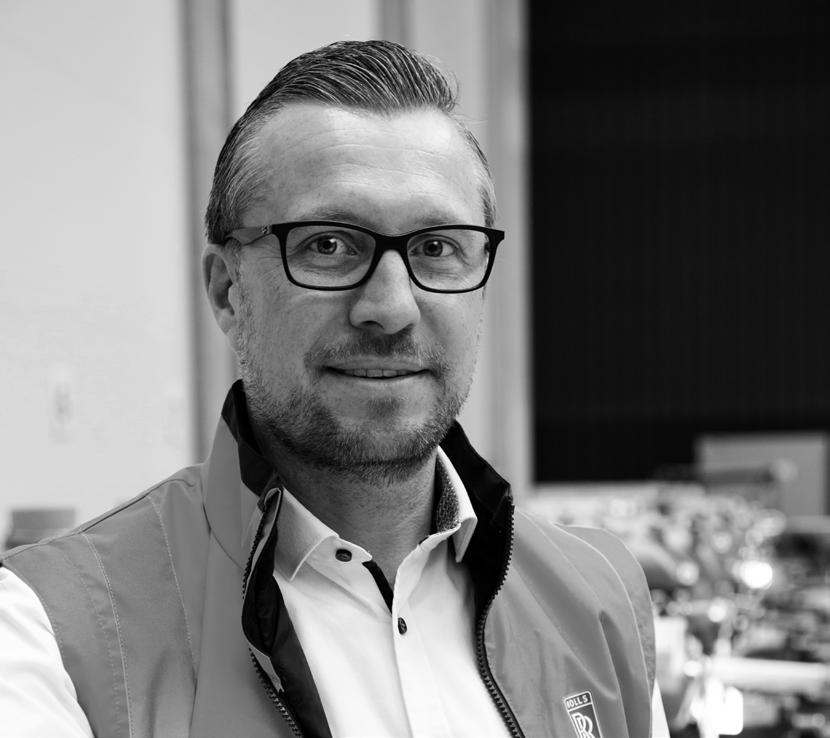
“We knew there was no single silver bullet, but also realised that investing in 20 directions wouldn’t yield viable business outcomes.”

Located down the road in Friedrichshafen, Plant 2 is the historic production facility where the mtu Series 4000 and other units such as the Series 8000 and 1163 are assembled. It is also where all the engines undergo final testing. As part of the company’s long-term strategy to modernise production and optimise throughput, flexibility and quality control, a multi-millioneuro investment project is underway to introduce the same automated technologies that have been successfully trialed at Plant 4 for the last two years. This new production area of 4,500 square metres is scheduled for initial operations by the middle of next year, with full implementation and transition to the final setup expected in early 2028.
Plant 2 may not yet be fully digitised, but it still represents a highly integrated, technically advanced production and validation facility. During the pre-assembly phase, for example, AI-based recognition systems validate bolts, washers, and fittings by size, type, and material, and provide real-time feedback on any mismatches. It is also equipped for full hot testing of engines under load, simulating real-world operating conditions to validate performance, emissions and system behaviour under stress.

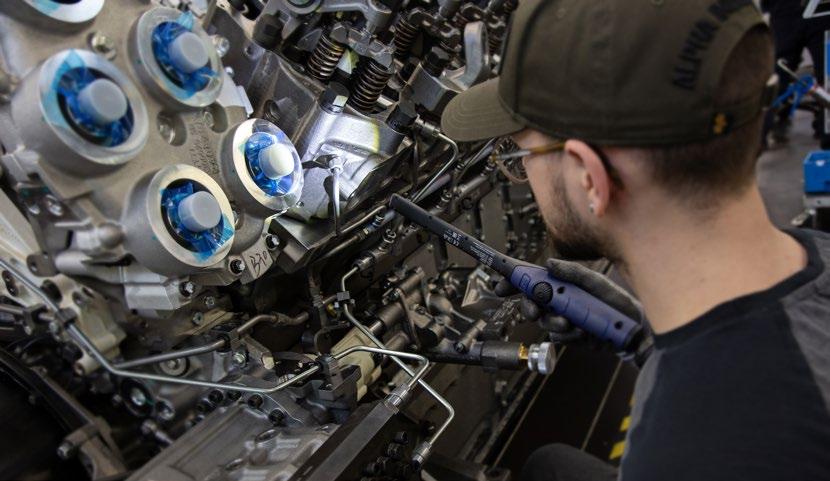

The 17 test benches are able to accommodate the whole range of mtu engines, thanks to modular engine mountings and reconfigurable systems that automatically recalibrate for the selected engine type. Two of the test benches are equipped with electrically driven dynamometers for energy recuperation. Instead of using water brakes to absorb mechanical energy as heat, these systems convert kinetic energy generated during engine operation back into electrical power – up to 4.3 gigawatt-hours of electricity annually – which can be used within the plant or fed into the local power grid.
Although all the engines undergo a leak test prior to hot testing, a secondary visual inspection is performed afterwards, as leaks can develop due to thermal cycling, fastener loosening, or gasket misalignment during high-vibration testing. Inspection teams use torches and UV-based leak detection systems to ensure sealing integrity. The painting department comprises five sealed paint booths with adjacent prep zones where engines are cleaned, masked and painted according to customer specifications. Standard units are typically painted in mtu's signature light grey (RAL 7035), but around 40 percent receive a non-standard finish (notably, one engine was painted pink for ScotRail, while another goldpainted unit was delivered to Italy’s Guardia di Finanza). After painting, the engines pass through one of four climate-controlled chambers where the coating is cured. After painting, chromed covers for the cylinder heads are a common custom request for superyacht engines. The final quality control gateway is another visual inspection before the engines are transferred to the dispatch area. From there, engines are logged into Rolls-Royce's logistics and tracking system, where they are matched with customer orders and documentation before being shipped around the world.
Bottom: The plant is not yet fully digitised, but it is still a highly integrated production and validation facility.

Beyond manufacturing, Rolls-Royce is investing heavily in R&D directed at both diesel and hybrid technologies with a clear focus on sustainability, modularity, efficiency and futurereadiness. Its hybrid propulsion solutions were originally geared towards ferries, work boats and naval vessels, but are now being installed on yachts by brands such as Azimut and Sanlorenzo (the first superyacht over 70 metres with a fully integrated mtu hybrid package is 76-metre Project Arrow, in build at Turquoise Yachts in Turkey and due to launch next year). Then there is its research into alternative fuels, where the gameplan is based on both technical innovation and the realities of the marketplace.
“We knew there was no single silver bullet, but also realised that investing in 20 directions wouldn’t yield viable business outcomes,” says Denise Kurtulus, Senior Vice President Global Marine at Rolls-Royce Power Systems. “So we made some strategic decisions.”
Hydrogen was ruled out for mtu marine engines early on due to the associated storage and safety issues. Methanol, on the other hand, emerged as a realistic future fuel for marine combustion engines that can be produced from renewable sources and stored as a liquid at ambient temperature, simplifying handling and logistical needs. Rolls-Royce’s research focused on methanol technology as part of the publicly funded MeOHmare project, including trials of a single-fuel solution on a full-engine test bed.



“Despite our readiness, however, there's still no viable market for single-fuel methanol engines,” cautions Kurtulus. “Green methanol is largely unavailable, infrastructure is lacking, and legislation is inconsistent. Our market model flipped from expecting a methanolbased market by 2035 to projecting that diesel will remain dominant, with dual-fuel methanol as a bridge.”
With this projection in mind, Rolls-Royce Power Systems continues to invest in optimising its diesel technology – still the most efficient combustion method available, particularly when combined with exhaust after-treatment systems and sustainable EN 15940 fuels such as HVO (Hydrotreated Vegetable Oil), a drop-in fuel that is readily available and can lower fossil CO2 emissions by up to 90 percent.
“Our future vision is clear: hybrid methanol or diesel-electric, depending on the size of the vessel, with future-ready architecture that lets us adapt without changing the engine footprint,” says Kurtulus. “Once infrastructure and regulation are aligned and the market is ready, we’re ready to lead the transition with a single-fuel methanol solution.”
In the meantime, Rolls-Royce Power Systems has been quietly transitioning from being a high-end diesel engine manufacturer into a full-system integrator that delivers complete, hybridised, future-ready propulsion packages. As part of this holistic Bridge-toPropeller strategy, which covers everything from power generation and propulsion to bridge automation, in 2020 Rolls-Royce acquired Servowatch, a leading supplier of ship control systems, and followed up in 2023 with Team Italia, the yacht bridge and automation specialist.
While mtu engines have traditionally served the propulsion needs of superyachts at the upper end of the size scale, including 180-metre Azzam, Rolls-Royce is now aggressively eyeing the market for smaller yachts. To this end, it has taken over ownership of the testing cycle of an integrated pod propulsion solution based on ZF’s POD 4600 coupled with mtu Series 2000 engines. Initially offering up to 1,250kW (1,700hp) and later expanding to 1,470kW (2,000hp), the platform is engineered to increase propulsion efficiency by up to 15 percent, reduce carbon footprints, and deliver superior manoeuvrability compared to traditional fixed propeller drives for yachts under 40 metres in length. Volvo Penta is a market leader in this sector with its IPS technology, but Rolls-Royce is seeking competitive advantage by leveraging its Bridge-to-Propeller capability.
This initiative ties in with a broader RollsRoyce ambition: to double its yachting business over the next 10–15 years. While superyachts make up the bulk of that turnover, most of the new growth is expected to come from the smaller production yachts, where competitive pricing is more critical but system integration can offer valuable product differentiation. As propulsion, automation and data systems continue to converge, Rolls-Royce is positioning itself as a technology partner offering full integration solutions tailored to meet the evolving demands of next-generation yachts – regardless of size.
“We can’t build the business on just the superyacht sector,” confirms Kurtulus. “We’re targeting the high-volume production segment now – without losing our premium edge. Whether it's preparing for smaller yachts or upcoming emissions legislation, we are not just reacting to market shifts – we are actively shaping them.”
“Our future vision is clear: hybrid methanol or diesel-electric, depending on the size of the vessel, with futureready architecture that lets us adapt without changing the engine footprint.”


Scan

Richard Pearce grew up sailing all kinds of boats near his family home on the River Hamble in Hampshire. The son of a naval captain, he studied naval architecture at Southampton and first worked for the Ministry of Defence, initially in submarine design and then in the Future Projects department, where he explored innovative naval concepts. Realising that working for the government meant his projects were unlikely to come to fruition, he joined maritime consultants Burness Corlett Three Quays (BCTQ). It was during his time there that a chance encounter launched his career as an owner’s representative. He set up Waterproof, his own Barcelonabased consultancy firm, in 2013. Over the years he has advised owners on projects such as Eclipse, Titan, Triple Seven, Solaris, Moonrise, Talitha G, Ecstasea, Sarafsa, Mogambo, Oberon, Halo and Air, among others.
BY JUSTIN RATCLIFFE



How did you make the transition from naval architect to owner’s rep?
I was working as a young naval architect on Octopus and Pelorus for BCTQ. One day, I was tasked with a pre-purchase survey for Le Grand Bleu and while on board, I met the prospective owner and his team walking down the crew corridor. They asked me if they could remove the lifeboats on her side decks and I told them that they couldn’t, because of the regulations. They didn’t much like that and argued that they’d been told they could, but I stood my ground. After they bought the yacht, they contacted me again about removing the lifeboats, but I stuck to my position. Eventually, they came back to me when they wanted to build a new yacht, which became Eclipse. I guess they appreciated my frankness. Over the years, I’ve found that saying "no" has led to the most significant opportunities. People usually appreciate honesty, even when it’s not what they want to hear.
How would you define your relationship with your clients?
It’s a professional relationship with a personal touch. I spend a lot of time with my clients, but I’m not their friend. They call me their "boat man" as one of many specialists they have for managing different aspects of their lives. I’m there to build them amazing yachts, but you have to give them the bad news as well and find a way to do that on a personal level. An owner's rep should be as upfront as possible, and from that you can build a relationship based on trust, which is key. If they trust you and you’ve built that rapport, they’re open to suggestions. But you need to approach it carefully, especially when it’s something they may not want to hear.
On the other side, you have to also build a relationship of trust with the shipyard. Yes, it’s a delicate balance. I’ve had both good and bad relationships with shipyards. Sometimes, there’s been tension for various reasons and I’ve been involved in arbitration, which is never good for the project, the client or the shipyard. Luckily, I've had ‘ethical’ clients in that they want to build good boats and they want the shipyard to be able to make money, but they don't want to be abused or overcharged. My job is to ensure that doesn’t happen and diplomacy plays a big role. Trust, honesty and clear communication from both sides are crucial.
Previous page, from top: 139.7m Solaris (Lloyd
How has your role developed since you started out in the business?
My job has evolved along with the industry. Everything is faster and the projects are more complex. I was using AutoCAD when I started out 20 years ago, but my job now is about facilitating and making sure everyone’s on the same page, keeping the client informed and prioritising decisions –more about managing the process and less about technical execution. Clients can get overwhelmed with too many choices and if you ask them to make 20 decisions at once, it just won’t happen. You have to focus on what’s most important and guide them through it step by step. If you can narrow it down to just a few key decisions, it keeps things moving and the project stays on track. Owners are generally receptive if you present the advice in the right way.
How do you make sure everyone is on the same page?
Every project needs a reason or an identity, which can connect the project team and client on the path of creation. For Pelorus it was groundbreaking design; for Octopus it was extensive engineering; for Nebula it was building a support vessel with a focus on helicopter operations, tenders and crew life. Moonrise was the client’s first new-build and was about allowing him to create something of his own, but also teaching him what he needed to know and guiding him through each step. Solaris was about pushing the design with novel solutions and building a project with features that many yards wanted to dilute. The whole process can be very rewarding when everyone involved understands the project’s raison d'être and can follow the necessary steps to achieve it.

It's a high-stakes environment to navigate –how do you manage the pressure?
It can definitely be nerve-wracking, but having a team around you that you trust makes all the difference. I’m fortunate now that I can choose my projects. I’ve made a conscious decision to keep my company small and lean. In Barcelona, there are just three of us and we have technical teams – project managers, naval architects, engineers, and interior specialists, either direct employees or long-term freelancers – working on individual projects. We fight, disagree, swap ideas, compromise, make decisions, but at the end we celebrate together. Yes, it can stressful, but it's also an adrenaline rush. And in the end, when it's all done, you look back and think, “Wow, we pulled it off!”
Zero soot technology for superyachts
Xeamos’ clean-air, soot-free and noise-reducing systems protect your family, friends and crew. Contact us to explore joining an exclusive club of owners who enjoy this peace of mind.





Reducing emissions together
XEAMOS | Bijsterhuizen 2209 | Wijchen | the Netherlands info@xeamos.com | T +31(0)24 648 6015 | xeamos.com

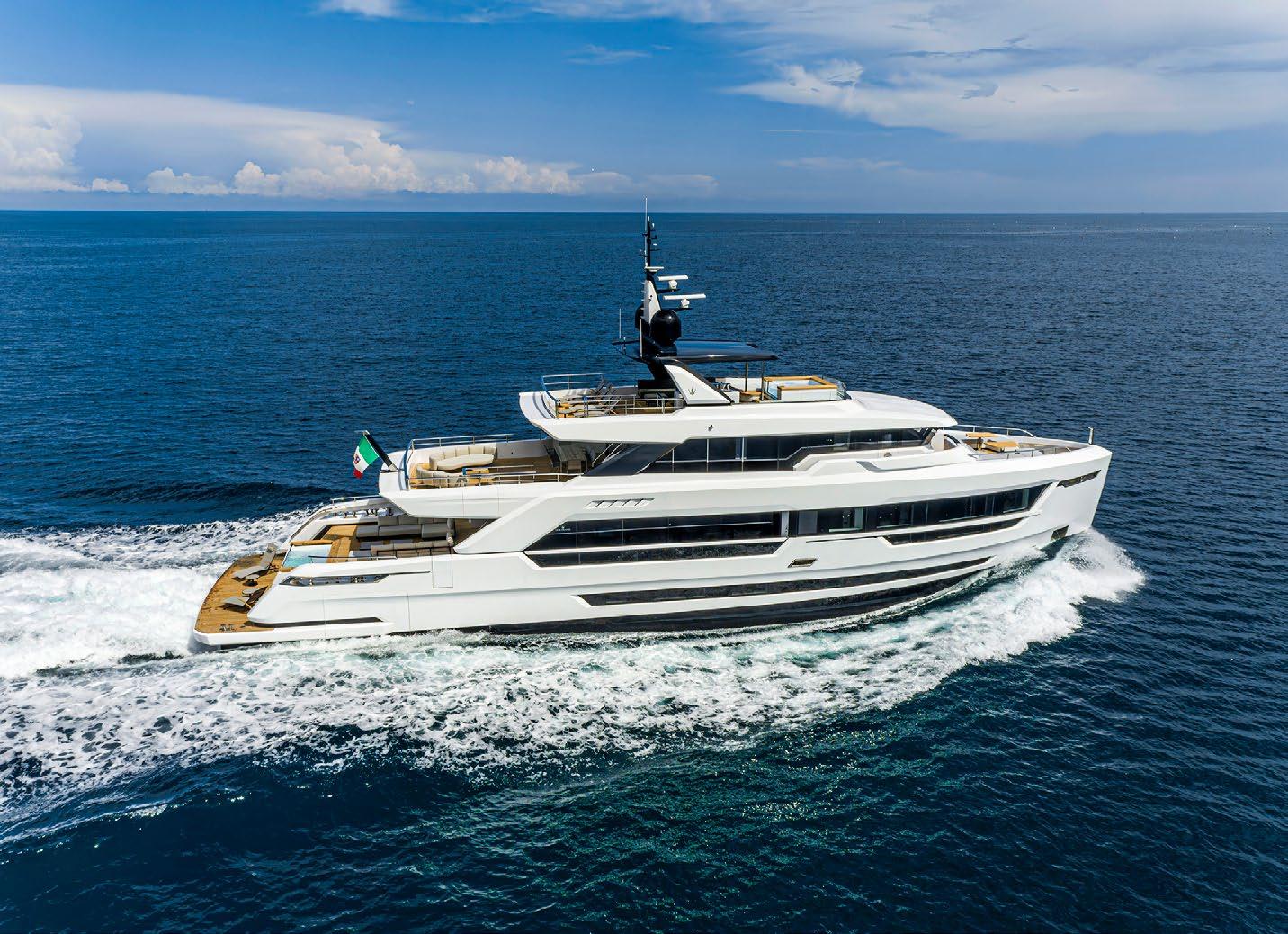


*equipped with 2 x WAF 464L
www.reintjes-gears.com


While the superyacht industry has largely kept pace with land-based AV advancements, streaming remained a bridge too far – until now. With fast global marine broadband unlocking new possibilities, AV-over-IP is finally finding its sea legs. What does this mean for AV architecture on board, and how is it transforming guest control interfaces?
BY CHARLOTTE THOMAS
“The availability of a broadband connection at sea was always a limiting factor – VSAT simply didn’t deliver the bandwidth to stream a Netflix movie.”
Anyone involved in a new-build or refit project knows the question is coming: When can I stream the same content I enjoy at home on my yacht? For years, that request has been met with disappointment. In the meantime, yachts have become more complex with bespoke control apps and dedicated touchscreen remotes that often felt more like piloting the USS Enterprise than kicking back for a casual movie night. But that’s finally changing.
“The availability of a broadband connection at sea was always a limiting factor – VSAT simply didn’t deliver the bandwidth to stream a Netflix movie,” says Daniel Kerkhof, Director of Crestron Marine. “Now the possibility is there, and everything is moving very quickly.”
The dawn of low-earth orbit (LEO) satellite constellations – vast networks offering high-speed, low-latency, and relatively cost-effective 200Mbps+ internet – has brought full streaming capability to nearly every ocean. And with the new tech comes a new aesthetic as VSAT domes are ditched in favour of the sleek silhouettes of yachts built for seamless streaming.

While it has taken time for the internet side of things to catch up, AV/IT systems onboard have evolved. The inclusion of IT networks using wired Ethernet or wireless connectivity isn’t new.
“The backbone has definitely changed –everything we do today is based on TCP/ IP traffic and standard LAN [local area network] connections,” Kerkhof explains.
That shift is the foundation of a broader move away from the traditional split between audio and video systems.
Today’s LAN-based systems replace hard-wired, point-to-point signal paths with IP-based architecture. Encoders and decoders stand in for traditional transmitters and receivers, while IP switches replace AV switchers. And because data is packet-based, there’s no inherent limit to the number of inputs or outputs-– you just add more switches.
This approach also eliminates the need for expensive specialty cabling to carry signals over long distances. Ethernet connections daisy-chained through switches deliver connectivity across virtually unlimited lengths – helping overcome signal degradation in steel or aluminium hulls. This is, essentially, the same packet-switching technology that powers modern streaming services.
Fortunately, many yachts already run CAT5 or higher-grade Ethernet cabling, so upgrading doesn’t always require a costly, invasive refit. AV-over-IP has been around for a while – Crestron’s DM NVX, launched in 2017, can distribute high-quality audio and 5K video over 1-gigabit CAT-5 cables.
“We predict there will be a lot less hardware on board, because data storage on board will be gone and yachts will use the cloud for file sharing and email hosting, plus streaming,” says Kees Groen, Director Technology & Innovation at Van Berge Henegouwen (VBH).
“But this means a requirement for a heavy IT backbone. We recognised that a few years ago so most of our yachts already feature Cat6a, Cat7 and multi-core fibre optic cables. Clients are experiencing the benefits of that now.”

Starlink is currently the most well-known and fully operational LEO satellite service, but it’s not alone in the race. OneWeb (Eutelsat) and Telesat are also live or nearing full deployment. OneWeb is expected to offer comprehensive, geographically unrestricted coverage by the end of 2025, presenting a credible and stable alternative to the privately owned Starlink. Meanwhile, Telesat is expanding its LEO network to 512 satellites.
Amazon has also entered the arena, recently launching the first satellites in its 3,200-strong Kuiper constellation, with full deployment targeted by 2029. Together, these initiatives are reshaping the global marine broadband landscape, driving increased competition, fostering more attractive pricing models, and introducing built-in system redundancy. The impact will be especially pronounced when LEO is paired with 5G connectivity near coastlines, delivering seamless coverage from port to open sea.
This technological leap could finally render traditional onboard media servers obsolete – those once-essential racks of locally stored content now appear more and more like relics of a bygone era.
The AV system aboard Gioia, a 43-metre Codecasa, was developed by Crestron and installed by Sereni Elettronica to support both private cruising and charter use. The owner’s top priorities were intuitive usability and clear separation between guest and crew areas – achieved through the implementation of dedicated VLANs.
“It’s a relatively lightweight AV/IT setup in terms of cabling, hardware and overall onboard footprint, yet it still delivers a fullfeatured entertainment experience,” says Daniel Kerkhof of Crestron. The yacht uses two Starlink antennas to provide high-speed broadband and features a powerful audio system powered by Crestron’s network-based amplifiers, allowing music or audio from video content to be played in any area, or all areas, of the yacht simultaneously in party mode.
“It’s also a super simple system to operate,” Kerkhof adds. “We use QR codes in guest areas; scan with your phone and you’re instantly connected to a web interface that controls the AV system, lighting, HVAC, and more. It’s far less complex and much lighter than traditional yacht AV systems, while still delivering all the flexibility and functionality you’d expect.”

“Today, for projects above a certain size, maintaining traditional AV architecture isn’t even on the table.”
“For at least five years we have been witnessing a progressive transition regarding the architecture of entertainment systems towards AV-over-IP,” adds Daniele Bonetti, technical engineer at Benetti’s Livorno shipyard. “The evolution of AV sources and the way they are used have started the process, while technological development has made new features available and increased the performance achievable in transmission and distribution of content.”
The arrival of high-speed connectivity has only accelerated the trend: “Today, for projects above a certain size, maintaining traditional AV architecture isn’t even on the table. AV-over-IP is the only option,” adds Bonetti.
AV-over-IP unlocks new possibilities. Instead of routing audio from the back of a TV to a soundbar, it can be pulled from the HDMI signal, encoded, and transmitted over the IP network – allowing distribution to premium speakers in that space or across the entire yacht. Video distribution is also possible although sending video-over-IP tends to be the preserve of larger yachts.
“For sub-60-metre projects, IP video distribution is less typical due to cost,” Kerkhof notes. “But that doesn’t mean it can’t be done – we’ve even seen tenders with compact AV-over-IP setups.”





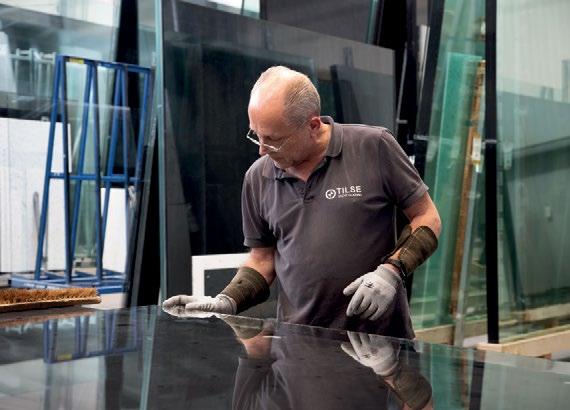
The rise of streaming onboard has shifted expectations around control interfaces and how guests interact with systems. Earlier this year, Videoworks introduced a new domotic control system that blends tactile control technology with the practicality of a traditional remote. Moving away from complex tablet interfaces in a return to intuitive design, users can easily manage not only TV channels and audio levels, but also lighting scenes and climate settings, all from a single, easy-to-use device.
“The idea came from listening to our customers,” explains Francesco Pierpaoli, Chief Information Officer at Videoworks.
“More and more, they’re asking for systems that are simple and intuitive. In a cabin, for example, having a physical remote with just a few clearly marked buttons is much more convenient than a touchscreen iPad.”
Bonetti agrees. “Custom remotes still play a key role – they simplify a wide range of functions beyond just AV,” he says. “But streaming platforms have changed the game. What I see is a return to the classic handheld remote for essential functions, often paired with tablets for managing larger environments.”
Kerkhof concurs, noting that while guests often stream from their phones, universal remotes remain popular – especially for watching TV from the comfort of a bed.
“Tactile buttons you can navigate by feel are still valued,” he says. “We’re also seeing more QR code integrations – walk into a room, scan the code, and access all controls from an HTML page on your phone.
VBH, meanwhile, has blended the concept of easy remotes with the interface that owners and guests are used to when streaming content at home. The result is Guida, a widget-based system that can control all aspects of the yacht’s domotics. Key is the MediaHub widget that pools all your streaming services under one app with a familiar interface. “Guida lives on the App Store and Play, and MediaHub allows for easy searching of content across the different streaming services,” says Groen. “Then you can instantly play that content on your TV or tablet or wherever on board you want to stream it.”

For Brian Faerber, Business Unit Manager at Eekels Technology, the Smart TV is now central to the guest experience and at the heart of their SimplySmartTV solution.
“We called it that because it’s easy to use,” he explains. “Clients often say iPad-based controls are too complicated. You sometimes need to press several buttons just to connect via Bluetooth. Our setup is like a hotel system – simple remote, intuitive interface, straightforward architecture, and reliable. How often does your Smart TV at home fail?”
He adds that guests want to stream their own content and play music from their own libraries, at which point the TV becomes an extension of their phone: “That’s where we’re heading. The Smart TV is the streaming source, so we can eliminate everything except the IT network. Our app integrates with the TV, enabling AirPlay, Chromecast, and familiar interfaces.”



The AV/IT system for Telli, a 38-metre Navetta 38 owned by Ferretti Group CEO Alberto Galassi, was developed by Videoworks to meet a very specific request: eliminate all domes. The yacht was designed without VSAT or TVRO antennas and instead relies on dual Starlink units delivering 220 Mbps broadband, complemented by 5G connectivity. This supports an IP-based AV/ IT ecosystem built around an HTML5 web engine, offering a seamless domotic interface across a range of user devices.
Hardware is consolidated into two main equipment racks, with a third smaller rack dedicated to decoder distribution – making efficient use of technical space. Notably, Telli relies exclusively on streaming for all media delivery, integrating Sky Italy streaming decoders and Smart TV apps for an easy-tonavigate entertainment experience.
“The owner wanted high-performance audio and ultra-fast Starlink connectivity to enable streaming, internet access, and a wide range of pay-per-view services,” explains Giovanni Varone, Yachting Sales Manager at Videoworks. “This is the first time we’ve deployed systems this advanced-– typically reserved for 60- to 70-metre yachts – on a yacht of this size.” A dedicated VLAN ensures access to geo-restricted content anywhere the vessel travels.

The AV/IT system aboard 52-metre Baglietto Akula integrates Starlink and 5G connectivity, with future plans to add OneWeb compatibility. Built on Cisco network infrastructure, the system delivers high-quality, audio-over-IP via the Dante protocol and supports 4K video streaming throughout the vessel.
Content is distributed over Ethernet and delivered through various methods, including local offline storage, ondemand video streaming, and pay-perview content via SkyStream boxes that stream directly to onboard Smart TVs. At the heart of the system is Videoworks’ MyInfo platform.
“Our MyInfo platform is designed for both audio and video content, tailored to modern streaming habits,” says Giovanni Varone, Yachting Sales Manager at Videoworks. “As more users shift to streaming-first consumption, MyInfo ensures a fully digital, network-based way to manage and enjoy onboard entertainment.”

“The real value in a yacht’s AV system lies in how easily it can be modified or expanded in the future with minimal disruption.”
The full potential of streaming and AVover-IP is realised only when legacy systems – VSAT, TVRO, media servers, outdated AV equipment – are removed. Some owners are ready. Others, not quite. “There are still those asking for some form of local storage,” Kerkhof acknowledges. “But is it really necessary? I don’t think so.” For owners, representatives and project teams planning new AV/IT installations, Bonetti is direct: modern integrators need telecoms expertise. He points out that RJ45 plugs have replaced RCA connectors and that designs must follow structured cabling principles for longterm scalability.
“The real value in a yacht’s AV system lies in how easily it can be modified or expanded in the future with minimal disruption” he concludes. “That means choosing the right cables, reserving space, planning for integration, and selecting the right brands. Most importantly, design it today so it’s still relevant tomorrow.”

Eekels Technology is currently developing an AV/IT system for a 100-metre-plus project that places Smart TVs at the core of the guest experience. The system provides not only access to all major streaming platforms but also a user interface that mirrors what owners and guests are accustomed to at home – a key consideration for large yachts where space, power and cooling come at a premium.
“Smart TVs are the ultimate streaming source,” says Brian Faerber, Business Unit Manager at Eekels Technology. “By shifting to cloud-based platforms and a simplified interface, we’ve been able to significantly streamline system architecture.” According to Faerber, the company’s SimplyStreamTV solution – with its fully IP-based setup – can cut investment and infrastructure requirements in half.
For a 120-metre yacht, this could mean eliminating up to eight traditional AV racks, significantly reducing cooling and power demands, and achieving a weight savings of around 2.5 tonnes – all of which also contribute to a lower overall carbon footprint.
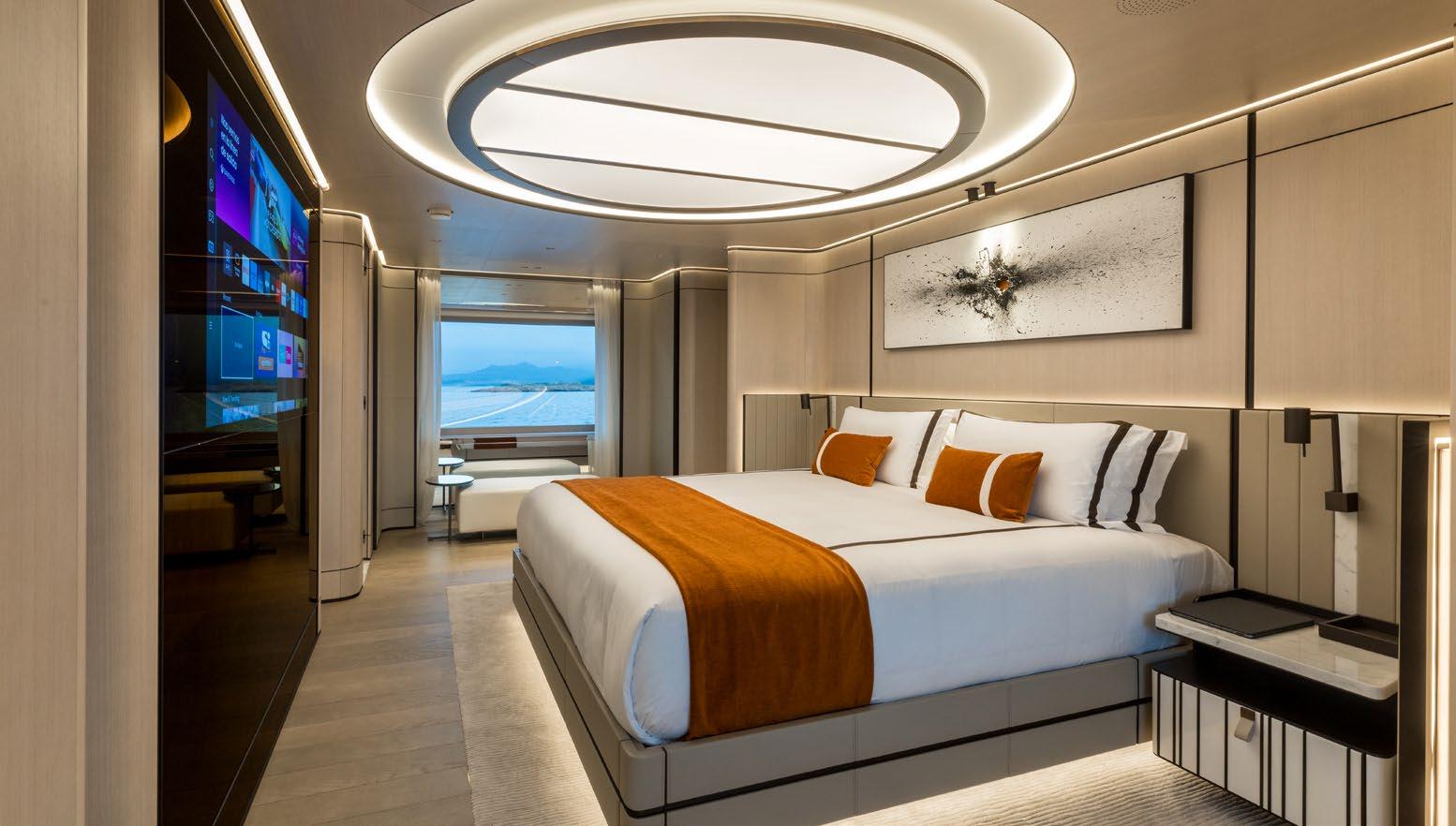
BY LATERAL NAVAL ARCHITECTS

There are few moments more creatively potent or more exposed than the earliest stages of a superyacht project. With a blank sheet of paper and a vision in mind, designers are tasked with giving form to imagination. But the earliest design moves, profile sketches, arrangement layouts, ambitions for speed, space or tonnage, carry real consequences. They set the tone and often the limits of what follows. In this phase, design energy is abundant. But technical clarity is often frustratingly just out of focus.
Some design studios arrive at the concept phase with a library of past experience to draw from. Others do not. Yet even those with deep portfolios still face the same challenge. How to underpin creative ideas with just enough technical certainty to be credible, without burdening the process with complexity or cost. Early design should be agile, not over-engineered, but it must still be feasible.
This is the space WaveForm was created to serve.
Developed by Lateral Naval Architects, WaveForm is a structured service that provides essential technical insight at the concept stage. It formalises an established approach into a clearly defined process, designed to support designers, brokers and shipyards by delivering the right level of technical input at precisely the right moment.

WaveForm is not simply an engineering checklist. It is a synthesis of tools, expertise and information disciplines, combined in an agile and efficient way to deliver real design value.
At its core, WaveForm draws on five foundational pillars:
- Parameterised data drawn from hundreds of publicly available and anonymised project sources, enabling comparative benchmarking and statistical validation. Supported by artificial intelligence, this data can now be explored in far greater depth. New insights emerge from patterns that were previously invisible, illuminating relationships between form, function and feasibility that sharpen early design intent.
- Empirical calculation methods refined through decades of applied naval architecture and marine engineering.
- Agile first-principles analysis that supports rapid iteration on dimensions, displacement, power, range and other key parameters.
- A deep understanding of the regulatory landscape, enabling early identification of statutory pinch points before they become project risks.
- An instinctive understanding of what matters most to different stakeholders at the concept stage, ensuring the right information is delivered in the right way.
From only a basic profile sketch, an outline general arrangement and a few performance targets, WaveForm delivers a structured technical output. This includes weight and tonnage estimates, propulsion architecture, power and range analysis, seakeeping assessments, statutory review and benchmarking against comparable projects.
Crucially, this information is curated and presented with clarity to support meaningful design discussion, creative development and stakeholder alignment.
WaveForm is a living document, not a static report. It adapts. As projects evolve, with changes to length, gross tonnage or client preferences, WaveForm evolves in parallel. This maintains alignment between design intent and technical feasibility throughout.
Underpinning this responsiveness is a foundation of AI-supported software that enables a high degree of hyper productivity. Design scenarios can be recalculated and revalidated quickly, preserving continuity while reducing rework and delay. That continuity builds trust, simplifies communication and supports smoother progression into subsequent stages of the project.
One of WaveForm’s defining characteristics is proportionality. It is designed to provide just enough insight to steer design feasibility, without overwhelming the creative process. It respects the momentum of early-stage design and supports it, adding clarity without adding drag. In doing so, it enhances credibility without imposing constraint. WaveForm also serves as a point of connection. At the outset of a yacht’s life, stakeholders often bring divergent views and definitions of feasibility. Designers, owners teams, brokers and shipyards each see the project from their own vantage point. WaveForm helps bring those perspectives into alignment by introducing a shared technical foundation. This creates the conditions for clear decisions, well-informed presentations and confident commitments.
This is not a product, but a service. A tool shaped by engineering knowledge and delivered with sensitivity to the realities of design. Its value lies in enabling creativity to progress with confidence, grounded in insight that is clear, credible and responsive.
At its heart is a simple but essential principle. The earlier a project can establish a technically sound foundation, the easier every subsequent step becomes. That is the shift WaveForm enables. From uncertainty to clarity. From isolated decisions to integrated thinking. From intuition alone to grounded ambition.
Because when the earliest decisions are informed by the right insight, everything that follows becomes more certain, more aligned and more achievable.




As more new-builds and refits look to incorporate energy storage systems, a new challenge arises for project teams – when should you commit to a battery technology, what new advances are on the horizon, and will your choice be obsolete by the time the yacht launches?
BY CHARLOTTE THOMAS
Opening page: The EST-Floattech Octopus battery system aboard a ferry
Clockwise from right:
Pouch cells are lithiumion batteries in a flat, multilayer laminate structure with an anode, cathode, and separator sealed in a pouch; Corvus Energy battery banks aboard Feadship’s 84-metre Obsidian (below).


When Feadship launched its first hybrid superyacht, 83.5-metre Savannah, in 2015, one of the most notable of her many innovative features was the size of her lithium-ion battery bank – a groundbreaking one megawatt-hour weighing close to 12 tons. The progress and adoption of battery technology since then has been exponential. Just eight years later, Feadship’s Obsidian carried 4.5 MWh of batteries, and a DC power grid that almost doubled in voltage from Savannah’s 560V to 1,000V. The recently launched 79.5-metre Feadship Valor ups that capacity again to 5.34 MWh. Energy storage is the ‘in’ thing.
Of course, others paved the way long before these much-vaunted projects. Royal Huisman’s 42-metre ketch Cyclos III, delivered in 1990, was arguably the progenitor of it all with a bank of gel cell batteries that allowed her to enjoy a hard day’s sail and a night at anchor free from the generator. And Ethereal, another gamechanging ketch from Royal Huisman in 2009, had a hybrid propulsion system that could store 400kWh of energy in a lithium-ion phosphate battery bank.



Modern batteries start with cells – individual pockets comprising an anode and a cathode, an electrolyte and a separator. In a charged lithium-ion battery, the lithium atoms are parked in the anode; the current forms when an electron leaves the lithium atom and travels to the positive terminal, leaving a lithium ion which travels through the separator to park in the cathode where it rejoins with its missing electron. Charging the battery reverses the process. Cells can be cylindrical, prismatic (block-shaped) or pouches (flat, like a hard disc), and multiple cells are combined to form a battery.
Advances come both from tweaking the battery chemistry – including the materials such as nickel and cobalt used to make the anode and cathode, and the liquid electrolyte that facilitates the movement of the lithium – and through cell design. For many years now, lithiumion (Li-ion) has been the dominant battery chemistry, thanks to its high-energy density for a given mass, which means it’s perfect for everything from electric vehicles to consumer electronics. Pouch cells are often selected for higher-end, higher-energy needs, because they offer better energy density, better ventilation for heat management, and a more flexible form factor for battery construction.
However, even within the Li-ion space there are competing technologies. The two current key Li-ion chemistries are lithium iron phosphate (LFP), and lithium nickel manganese cobalt oxide (NMC).LFP is cheaper but NMC has great power density, making it preferable for high-end applications. However, LFP has a slightly better safety profile, and a longer lifespan when viewed in terms of cycles. For typical superyacht installations, those elements are less relevant – all battery systems are rigorously tested and typeapproved by class societies such as DNV, Lloyd’s, BV and ABS.
One new development sneaking into the space between LFP and NMC is lithium manganese iron phosphate (LMFP), essentially an LFP battery but with manganese used as a component for the cathode. This gives it a 15–20 per cent energy density boost over a standard LFP battery, slotting it neatly between LFP and NMC.
Other chemistries include nickel-metal hydride (NiMH), which has a lower energy density than LFP; sodium-ion, which is touted as a lower cost alternative to LFP but currently with less energy density; and lithium sulphur (Li-S), which promises greater energy density than NMC but has several hurdles to clear before becoming commercially viable, including problems with stability and a limited cycle life.

BY LAND & SEA
Meanwhile, the land-based EV market has advanced in leaps and bounds with batteries delivering ever-increasing range and faster charging. The marine industry follows the EV market, and there are a lot of ongoing developments there in terms of the cells and their chemistries that form the building blocks of batteries. Lithium iron phosphate (LFP) and lithium nickel manganese cobalt oxide (NMC) systems continue to see improvements and will stay relevant for the foreseeable future, but many of us are waiting for the next big leap in battery technology. Graphene, silicon, solid-state, bio-batteries, and beyond – we’re constantly told we’re on the cusp of the next leap forward. This makes it difficult for project teams to know when to pull the trigger on tech that may be out of date by the time a yacht hits the water.
“It’s true that energy density has increased significantly – and is still improving,” says Mark Witjens, CEO of EST-Floattech, the Dutch tech company that develops and supplies energy storage solutions for maritime applications. “For example, we began production on the latest version of our Octopus System batteries two years ago, and already by the end of this year we’ll have an updated version offering a 20 percent increase in energy density. Battery systems need to be considered early in a project, but if improvements are made between ordering and installation, we’ll of course supply the upgraded versions.”
However, as EST-Floattech CTO and cofounder Diederick Stam points out, there is a limit in terms of how much you can develop cell energy density:
“More energy per cell effectively equates to more current, which means bigger cable sizes – and even if you scale to larger cables that are still flexible enough for installation, you might not be able to get connectors to fit. You can’t just keep on improving in one direction without sacrificing other things.”



One of the most promising new technologies is solid-state batteries. These use a solid electrolyte in place of a liquid, which not only has the potential to greatly increase energy density (initial estimates suggest 2.5 times that of an LFP battery, and 1.6 times that of an NMC battery), but also enhances safety as there are no liquids to leak, rendering it less susceptible to puncture damage. It will likely be five years or more, however, before solid-state batteries will even be a menu item for marine use.
And it’s not just about chemistry – other technologies are showing some potential. Supercapacitors, which store energy via static charge rather than using an electrochemical reaction, are capable of fast charge and discharge and can hold much higher densities of energy than batteries. They also promise a longer cycle life and less cooling. For instance, supercapacitors are good for quick bursts of power, while traditional lithium-ion batteries are better for longer energy duration. Witjens thinks they could be viable in a much shorter timeframe than solid-state batteries, albeit at a high cost, and pairing them in hybrid
systems could be the sweet spot – kind of like having both a sprinter and a marathon runner on the same team.
“Most people don't realise that the type of battery you need very much depends on what you're going to do with it on board a vessel – they think a battery is a battery, but that's not the case,” warns Witjens. “With all the different chemistries available, you can’t say one is better or worse across the board. Each has its ideal application.”
An obvious contrast is between a large battery bank that supplies power as part of a hybrid power and propulsion system on a superyacht, and the demands of an electric tender or toys that may be in continuous use during the day.
“Batteries are like people,” he continues. “If you use them a lot and push them hard, they heat up – so you need to cool them. But the type of battery you need also depends on how it’s used. A system with a relaxed cycle – charging overnight and discharging during the day – is very different from one that cycles 15 times a day with high charge and discharge rates.”
“With all the different chemistries available, you can’t say one is better or worse across the board. Each has its ideal application.”

Safety fears continue to surround batteries on board, either because of the DC voltages present in DC grids, which can be instantly fatal, or fire events caused by the dreaded thermal runaway. Diederick Stam of ESTFloattech points out that such instances are increasingly rare – and even if they do happen, modern cell design and the BMS have been optimised to limit the potential for catastrophe.
“We took a deep dive into safety – literally setting batteries on fire to understand what’s happening and how we can mitigate it,” says Stam. “That research fed directly into the thirdgeneration Octopus Series system we currently offer. We moved away from using very large cell formats and switched to smaller cells to give us more control in the event of a thermal incident. That way, if the worst happens, the impact is minimised and it’s easier to manage the situation. A lot of effort went into the design and testing to ensure that if a single cell enters thermal runaway, it won’t spread to neighboring cells. On top of that, we’ve built in redundant systems within the battery management system itself, along with software that continuously monitors and manages performance.”
Fundamentally, the system architecture and the battery management system (BMS) that controls everything and that interfaces with the rest of the yacht’s power grid remains the same regardless of the underlying energy storage. Indeed, EST-Floattech has designed its BMS with exactly this in mind, so that no matter the battery technology selected, the interface with the rest of the system is consistent.
An energy storage system starts with the individual batteries, each of which has a module controller that monitors each cell within the battery, and several batteries are then linked in series into a string. Strings are joined together in parallel, with each string also having a string controller, as well as fuses for safety and a lot of electronics to manage the strings and make sure they work together properly.
“In the case of multiple strings, a system controller is used – and it’s designed to make things easier for the system integrator,” explains Witjens. “They only need to get their PLC [programmable logic controller] to communicate with the system controller, which provides all the necessary data, while the power flows directly from the string controllers into the system. This way, we only need one system that can handle different battery types, and integrators only have to set up their PLCs once.”
When EST-Floattech started out in 2009, a cell with just 700Wh capacity could cost a thousand dollars. Much has changed since then and battery tech will only become more important as the industry transitions into alternative fuels and systems – not least because most of them don’t like load variations, while batteries handle dynamic loads very well.

Stam’s advice for anyone involved in a yacht project that incorporates energy storage is straightforward: talk to an experienced battery system supplier as part of the specification process, because the exact combination of AC and DC grids and components these days can be so complex that each operational case demands its own tailored solution.
When it comes to the technology itself, his advice is even clearer: don’t get swept away by promises of new stuff that may be just around the corner, because the next significant step is still a few years away. It’s better to stick with proven battery technologies than risk issues with new ones that don’t have a track record.
And Stam’s final words of wisdom? “Don’t pay attention to fancy companies that are claiming the best of the best for whatever parameter you are looking at, because the old adage holds true: if it looks too good to be true, it probably is.”
A 3D render of a onboard battery setup. Each battery has a module controller that monitors each cell within the battery, and several batteries are linked in series into a string.


The steel and aluminum Perini Navi ketch Belle Brise has been through various refits during her 30-year lifetime, but none quite like the one nearing completion at the Lusben shipyard in Livorno. More rebuild than refit, the extensive upgrades are aimed at honouring her classic heritage while ensuring she remains relevant in today’s yachting market.
BY JUSTIN RATCLIFFE
“The idea behind the rebuild is that she will serve for at least another ten years without any major works beyond the standard maintenance.”
Before the current owner acquired the 48-metre ketch in 2022, a pre-purchase survey reported the yacht in good overall condition. A phased refit over two winters was planned focusing on a few key upgrades: replacing generators, updating electronics, and carrying out minor cosmetic work. However, delays triggered by post-Covid supply chain issues, including a 14-month wait for the new generators, quickly disrupted that plan. Matters escalated when a high-pressure water jet used to clean the tanks punctured a corroded steel plate. The owner still has a dispiriting video clip on his phone of water pouring out onto the ground.
“After that we came across other surprises, which is when we decided to turn the refit into a full renovation or rebuild and pursue Restricted Commercial notation for future charter operations,” says the owner. “Constanty going from one refit to another isn’t ideal for an owner like me who wants to make full use of his yacht, so the idea behind the rebuild is that she will serve for at least another ten years without any major works beyond the standard maintenance.”



To oversee the process, the owner brought in Seamotion, led by CEO Susanna Corsagni. Having worked for over 25 years at Perini Navi and contributed to the delivery of more than 50 yachts, Corsagni was well suited to the role of owner’s representative. Lusben, likewise, was a logical choice for the refit, having a long history of refurbishing Perini yachts – including Maltese Falcon in 2023 –and a new 8.5-metre-deep keel pit purposebuilt for large sailing yachts.
Originally launched as Corelia in 1993, Belle Brise was fully designed in-house by Perini Navi. She was the first in a series of steelhulled motorsailers to feature a more modern reverse transom – boosting hull volume and enabling a flush hatch that folds down to water level for direct access from the lazarette, which boosted hull volume in the stern and enabled a flush hatch that folds down to water level for direct access from the lazarette. Her solid build and classic Perini lines were what initially attracted the current owner, but the passage of time had taken its toll on the yacht’s systems and machinery.
“Beneath the signs of age lay the heart of a classic masterpiece,” says Corsagni.
“The goal wasn’t to reinvent her, but to preserve and elevate her essence through a meticulous reconstruction.”
Unlike a restoration project aimed at total preservation, the approach with Belle Brise was to modernise the yacht without compromising her timeless character. The hull, superstructure and interior remain mostly intact, but key systems – propulsion, electrical, plumbing – were upgraded or replaced to meet today’s environmental and regulatory standards. To achieve commercial notation, both ABS and Malta Flag required significant upgrades to firefighting systems, emergency protocols and life-saving gear in line with charter operations.
The first phase involved scanning the hull to assess steel thickness and uncover corrosion. All filler was stripped, and the hull and topsides were sandblasted to bare metal.
Portions of the tanks were rebuilt (with new manholes added for easier maintenance), and some hull plating was replaced before receiving a full Alexseal paint system.
The bilges, engine room, and pump room were also sandblasted and repainted. These were then re-engineered in 3D to optimise space for modern systems. While the two original MTU engines were undergoing reconditioning, the decision was made to upgrade to more powerful and efficient 588kW (800hp) MAN engines equipped with urea-SCR technology to improve performance, extend the yacht’s operational range and comply with emissions regulations.
Two new 80kW CAT C4 generators were added along with a Gianneschi air compressor (the original emergency generator was fully refurbished) and a new battery pack is housed in a cabinet in the forward dining room on the main deck. All the pump room equipment has been upgraded with new boilers, Idromar MC5s watermakers, Dometic Condaria HVAC system, Hamann sewage plant, Idromar UV and silver-ion water treatment, ATUs and fancoils.
“Integrating modern systems into the original design presented a number of technical challenges,” says Alessandro Lazzerini, who spent 18 years as a project manager at Perini Navi. “The lack of space in certain areas required creative problem-solving, including the modification of structural elements to accommodate the new space under the engine room to house two 1,500-litre urea tanks.”



Left: The stripped out engine room before repainting.
Below: In the wheelhouse, a digital Furuno navigation suite with full ECDIS replaces the original analogue consoles.
Lusben’s new keel pit – the largest in the Mediterranean – proved crucial for extracting the lifting keel’s piston, a job that took three full days, and a new one was custom-machined by Mecline in Carrara. Lusben general manager Ferdinando Pilli was instrumental in establishing the keel pit that opened in June 2024. With a career that began as a naval officer and spans the new build and refit worlds for Perini Navi, CRN and Benetti, he has introduced a more holistic approach to refitting, a mentality that helped steer the project from a standard refit into a more comprehensive rebuild.
“My background has certainly broadened my perspective, moving away from the ‘this is how we've always done it’ approach,” says Pilli. “Working in new-builds, refits and technical operations has led me to adopt a wider vision that integrates the engineering aspects with comfort, aesthetics and usability.”
Unusually, Pilli allowed Seamotion to manage part of the supplier and subcontractor chain directly – leveraging long-standing relationships to ensure quality, reduce costs, and maintain tighter control over key decisions. For example, Corsagni’s team coordinated all rig and sail system upgrades with Rondal and Rig Pro.
Additional upgrades include new emergency Pro Energy AGM power packs, a full CCTV and A/V system from Videoworks, and allnew cabling, control panels and monitoring system from Cantalupi. Around 70 percent of all piping was replaced, with the remainder painstakingly cleaned and hand-polished by the crew. A new shore power transformer and emergency steering system were installed in the lazarette, along with a new Seares shell door damping system. The laundry was refitted with Miele marine-grade appliances, new plumbing and grey water tanks.
Susanna Corsagni joined Perini Navi as a young sales assistant and rose through the ranks to become head of contract management and director of coordination for all new-build project managers. She left after the company changed ownership in 2017 to take up an offer from a client to manage his fleet of vessels. Her initial motive for setting up Seamotion in 2022 was because she felt Perini owners did not receive the “family” treatment they had enjoyed in the past (three of her current projects are with owners of Perini yachts). Assisted by project manager Leonardo Gennai and architect Fabio Menichelli, Corsagni offers a suite of services as the main point of contact between owners, family offices, designers, naval architects and shipyards.
“We don’t pretend to compete with giants like Burgess and Camper & Nicholsons,” admits Corsagni, “but I think we stand out with our tailor-made approach, working to deliver exactly what the owner wants. Being smaller and having fewer clients allows us to be fully hands-on, every day.”
In addition to Belle Brise, the company is overseeing the refit of another 50-metre motor sailer at Lusben, a 60-metre sailing yacht at The Italian Sea Group Marina in Carrara, a 25-metre motoryacht at Amico & Co, and a new-build 50-metre motor yacht at Tankoa. Seamotion was a gold sponsor of the 2024 Gulf Superyacht Summit in Dubai.



The aluminium masts and their in-furling system for easier sail handling as envisioned by Fabio Perini underwent a full overhaul. This included non-destructive testing, new filler work and repainting of the masts and booms by Sail Solutions–Rig Pro. Cantalupi supplied new cabling and LED lighting, the rod rigging was replaced by BSI and the running rigging by Soluzioni Tessili. Bamar overhauled the furlers and added new outhauls.
Because the new rigging required compatible tip cups (the sealed points where the shrouds terminate on the spreaders), it made more sense to install new spreaders by Rondal that were also designed to accommodate Starlink antennas for alwayson high-speed connectivity (although pre-cabled for VSAT, Starlink is now the yacht’s primary means of communications).
The original Perini Navi winches – main, mizzen, fisherman, staysail and genoa – were overhauled and their hydraulic systems upgraded for optimal tension and reliability. The decks were entirely re-laid with 18–20mm teak planks by Arredo Teak, and new handrails installed to meet commercial
codes. New lockers on the foredeck provide life raft storage and double as wave breakers to shelter a new Lomac Euforia tender on its chocks. Most of the deck hatches were replaced with new ones by Iacomelli.
In the wheelhouse, a digital Furuno navigation suite with full ECDIS replaces the original analogue consoles. The bridge also features a new Anschutz gyrocompass and a certified monitoring system from Cantalupi, which is repeated on the flybridge and in the crew mess.
The interior remains true to the yacht’s heritage. The solid mahogany joinery and marble wet surface have been restored in both the guest and crew areas, and refreshed textiles and finishes tastefully integrated into the classic look offer a more up-to-date vibe. The galley was completely rebuilt with firerated insulation, new pipework, commercialgrade appliances, and a walk-in cold store. Original light switches and outlets were restored and all lighting converted to LED by Cantalupi. Lastly, to meet commercial safety codes, all 33 opening portholes in the hull were replaced with sealed versions customcrafted in stainless steel by Fabbri Fiore.
Facing page: Unstepping the
With facilities in Livorno, Viareggio and Varazze, earlier this year Lusben announced the completion of an investment plan launched in 2023 to strengthen operational capacity and expand its Livorno production site. The expansion marks a significant milestone for Azimut-Benetti’s refit division, which invested €12 million to redevelop the facility, doubling its size to 220,000 square metres. Of this, 90,000 square-metres are dedicated to onshore infrastructure, while the remaining 130,000 square-metres form an adjacent water basin. The newly expanded site can accommodate up to three yachts over 100 metres at the same time and includes a 2,400-tonne synchro-lift, a 180-metre floating dock, a dedicated dry dock for in-water maintenance, and the new keel pit.
“We’re also enhancing hospitality facilities for crews and constructing new office buildings – the final major investment needed to ensure we remain competitive and attractive,” says General Manager Ferdinando Pilli, who is looking to bridge the gap between the city and the shipyard as in other prime yachting locations.




There are very few examples of refurbishments as comprehensive as Belle Brise. By the time she departs Livorno in September, she will have spent over two years at Lusben – a sobering prospect for the owner but one that he accepts with equanimity as best for the project. Looking back, he concedes that opting for a rebuild from the outset would have saved both time and money. But refitting – especially to this extent – is inherently unpredictable. Faults emerge, tough decisions are made, and the line between “enough” and “ideal” is constantly reevaluated.
Could the team have done less? Certainly. But the outcome would have been less than ideal. Instead, the rebuilt Belle Brise has been transformed into a thoroughly modern motorsailer with a classic soul that will continue to be a symbol of Perini Navi’s enduring design and craftsmanship for years to come.


As a leading OEM driving innovation in yacht equipment, Akerboom’s new wireless remote system unites usercentered tech with real-time feedback


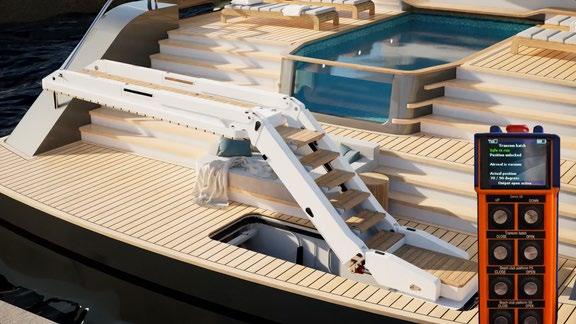




24|27 SEPTEMB ER 2025

Sea Level is a firm of naval architects and engineers based in Amsterdam specialising in what it calls ‘Feature Integration Technology‘ or FIT – devising tailor-made solutions to best implement custom features into the complex structures and systems of superyachts. Managing Director and partner Jeroen van der Knaap explains further.
BY JEROEN VAN DER KNAAP
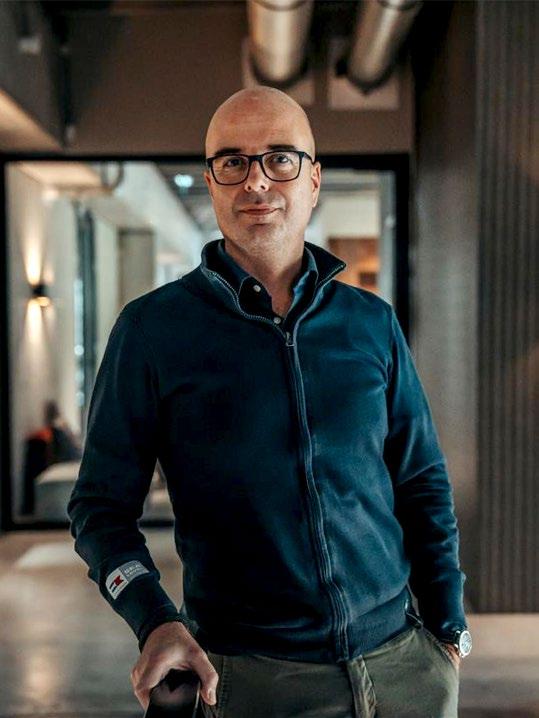
The superyacht industry is always on the move. While the sector is occasionally labelled as ‘traditional’, the trends we’ve seen over the years tell a story of dramatic change and innovation. Admittedly, these trends evolve a little more slowly than, say, in the automotive world. But that’s hardly surprising, as it takes considerably more time to build a superyacht – especially a full-custom project –than to manufacture a luxury car. It is equally clear that yacht designs are becoming increasingly complex. One key factor is the way we’re constantly challenged to integrate ever more – and ever larger –tenders and toys on yachts. Whereas tenders once sat visibly on deck or neatly tucked

into a superstructure recess, today they’re expected to disappear into the yacht, hidden behind garage doors. And then there are the heli-decks, the pools with jet streams, multiple Jacuzzis spread across different decks, expansive beach clubs, private owner’s balconies. All these amenities, and more, have become the norm.
Incorporating so many special features – and to get them right first time – requires focus and expertise throughout the development process. This is where Feature Integration Technology (FIT) comes in. But what exactly does FIT involve, and why is it so important to include it from the very start of a superyacht project?

Feature Integration is a specialisation focused on designing practical interfaces that allow intended features to be seamlessly incorporated into the yacht’s structure in exactly the way they’re meant to function.
So what, exactly, is a special feature? They are the individual items on the owner’s wish list, brought to life by the designer, which shape the overall onboard experience, enhancing enjoyment, comfort, usability and safety for owners and guests. Apart from tenders and toys, they include deck cranes, side terraces, folding bulwarks, passerelles, boarding ladders, provision doors/platforms, sun awnings, exterior showers, and tender handling systems. Off-the-shelf in only a few
cases, they mostly involve one-off solutions and even recurring features are likely to demand custom answers.
These bespoke features inevitably disrupt the organised, continuous structure of a large yacht, as each requires openings or penetrations to make room for installation. When drawing up a general arrangement, naval architects design the hull and develop the construction plan based on a set of structural calculations. This forms the backbone of the yacht – the keel, frames, web frames, girders, longitudinals, bulkheads, decks, and so on. Together with the shell plating, this framework represents a closed system that ensures the structural integrity of the vessel.
Integrating new elements into this framework creates technical challenges that have to be resolved. First and foremost, the structural integrity of the yacht must be maintained, which means solutions have to safeguard both strength and watertightness. It’s crucial to address this as early as possible as both Class and Flag authorities need to give their approval before going ahead. Planning for local modifications also involves performing local strength calculations to ensure continuity in both structural strength and stiffness.
At this early stage, we also consider how the feature will connect to the ship’s internal systems. What services need to be routed to it? Will electrical connections or hydraulics be required? How will the feature be installed – from the outside in, or the inside out? Will there be access for the installer?
Finally, we start thinking about accessibility during the design phase for service, maintenance, repairs and eventual replacement of components. For example, will the painters still be able to gain access once the yacht is built? This phase is also the right moment to consider how the crew will interact with the vessel later on. With this in mind, we carefully assess the functionality, handling, safety and logistics in relation to each feature.
Let’s take the example of a tender garage on an 80-metre motoryacht. The tenders and toys are stored behind large shell doors and the crew must be able to roll them out to the edge of the deck, directly beneath the overhead cranes. Practical and safety considerations mean keeping the deck free of obstacles. Once the hull doors are open, the tender is hoisted out. This means it is crucial to know the tender’s design right from the start, as the weight and centre of gravity determine the exact position of the lifting points. Usually, there are only a few centimetres of overhead clearance in the garage. And if the tender garage is located forward, the crane tracks may need to run perpendicular to the ship’s side shell, which misaligns with the ship’s customary longitudinal and transverse structure. The overhead cranes must be positioned to function smoothly, which means the entire structure beneath the foredeck has to be able to accommodate them. The height of the crane rails is another balancing act: they need to be strong enough, but not so bulky they interfere with the garage ceiling and the hoisting clearance. Naturally, the hull door must swing open far enough to allow the crane rails – and the hoisted tender – to move well clear of the yacht. We work closely with the yard and the
owner’s team to determine exactly how the tender is meant to reach the swim platform, where guests will be waiting, and how the craft will return to the tender garage afterwards. If this logistics flow requires any additional provisions, we can make arrangements to ensure everything functions as intended. It is becoming increasingly common to have to accommodate as many as three different fuel types for tenders and toys: diesel, petrol and lithium-ion batteries (expect more as alternative fuels come online). This makes designing a tender garage arrangement even more complex, especially as rules and regulations in this area are still evolving. Increasingly we’re required to include fireproof partition walls for proper separation.
In this particular example, the tender garage is located in the bow, directly above the crew quarters. The escape route for the crew needs to run from the deck below the tender garage out to an external deck. In this case, that means the escape route must pass through the tender garage itself, which brings its own set of challenges and regulatory demands in terms of insulation and watertight integrity. To resolve this issue, we created a stairwell that runs through the tender garage, allowing the crew to move safely and securely from the lower deck to the foredeck.

Top:

First and foremost, structural integrity must be maintained, which means solutions have to safeguard both strength and watertightness.

FIT applies both to new builds and refits. For the latter, we’re often asked to get involved when deck cranes need to be adapted for lifting tenders or MOBs. When an owner asks for a bigger tender, for example, this typically means more weight and less room for crew when launching and retrieving. Furthermore, is a heavier-duty crane required? Does the deck structure need reinforcing and, if so, what will that entail? Will we have to start ripping out interior spaces?
We visualise the proposed setup and check feasibility from all angles. In addition, our database includes a wide range of deck cranes and simplified FIT models of tenders and toys, allowing us to test the new handling setup early on. We also assess the crane’s lifting capacity (SWL, reach, etc.), its foundations and the existing ship structure. Should upgrades be needed, we propose the right modifications and handle potential communications with Class and Flag authorities to get plan approval before the work begins. In short, everything is geared towards avoiding hiccups and delays during construction.
Every scenario – right down to drainage, lighting, and the exact placement of control panels – should be carefully analysed during the design phase. Input from captains is helpful at this stage, as they can provide insight into everyday use, functionality, safety, ergonomics and logistics. When designing something like a tender garage, we consult closely with the crew to determine the best locations for control panels, remotes and safety equipment. To help them make fast and well-informed decisions, we also create detailed 3D visualisations of the onboard situation that include sightlines and all relevant geometry of the yacht, tenders and toys, within a single model. It is equally important that all disciplines involved in shaping the final design of the yacht engage in regular detailed consultations from the early stages of a project. While each discipline at the yard has its own responsibilities, integrating special features requires cross-disciplinary communication.
This is where FIT helps prevent costly surprises or hold-ups further along the line, making life easier for the yard. And last but certainly not least, it ensures that owners, guests and crew can enjoy a safe, comfortable and enjoyable onboard experience.




With 2,222 mhp (1,634 kW), the new mtu 12V2000 M96Z sets a new benchmark in yacht propulsion. This latest evolution of the mtu Series 2000 combines increased power density with optimized installation space and thrilling acceleration. Reinforced components, an advanced turbocharging system, and HVO compatibility make it more durable and more future-ready than ever.
For those who don’t just measure power – but feel it.

Find more details on our website.

Superyachts are the embodiment of luxury and style, but beyond the aesthetics they are subject to the same rules of naval architecture as all seagoing vessels. Andy King, Director of Stability & Statutory for Houlder design consultancy in the UK, discusses the importance of conducting detailed inclining experiments.
BY ANDY KING
“As the centre of gravity rises, the righting lever decreases, reducing the yacht’s ability to return to upright.”
Ayacht stays afloat and remains upright due to its design and carefully verified stability calculations. But why does it float? Why does it stay upright, and why does it return to an upright position after being disturbed by wind or waves? These questions are answered by understanding a yacht’s displacement and centre of gravity.
Displacement and centre of gravity comprise everything onboard, including the yacht itself. While the weight and position of items onboard can be estimated, the weight and centre of gravity of the yacht must be determined through a practical measurement known as the inclining experiment. This technical exercise is essential, with significant contractual and operational consequences.
“The inclining experiment is a crucial step in any new build project,” says Edmund Beckett, Head of Semi-Custom Yachting at Burgess. “Ensuring an accurate assessment and calculation, with results that reflect the completed yacht, is always key for us. The results of this initial inclining experiment form the foundation upon which the yacht's operating conditions and stability booklet are created and approved.”

The inclining experiment reveals much about the yacht. It determines the centre of gravity's position in all directions: longitudinally, transversely, and vertically. This information allows the calculation of the metacentric height – the distance between the centre of gravity and the metacentre, also known as GM. The experiment also determines the yacht's lightweight, which refers to the weight of the bare vessel. To visualise this: imagine turning the yacht upside down and shaking out everything onboard. The items that fall out are considered the deadweight (variable items like tanks and stores), while everything that remains in your hands is the lightweight. However, there are exceptions, which we will explore later.
The lightweight and centre of gravity are crucial for any large yacht. The total displacement, which is the sum of the lightweight and deadweight, determines the yacht’s draft. The longitudinal position of the centre of gravity determines its trim, and the vertical position plays a key role in its stability.
A yacht floats at a specific draft because the volume of displaced water equals the yacht's total displacement – the essence of Archimedes' principle. If either the lightweight or deadweight increases, the yacht’s draft must increase to maintain this balance. Alternatively, if the lightweight increases, the deadweight must decrease, or vice versa.
The centre of gravity is central to stability. For a yacht to remain stable, its centre of gravity must be below the metacentre. The metacentre is the point where the centre of buoyancy intersects the yacht's centreline when the yacht heels. When the yacht tilts, the centre of buoyancy shifts, creating a distance between the centre of buoyancy and the centre of gravity, known as the Righting Lever, which allows the yacht to return to an upright position.
As the centre of gravity rises, the righting lever decreases, reducing the yacht’s ability to return to upright. If the centre of gravity rises above the metacentre, the righting lever becomes negative – a capsize lever – and the yacht will not recover. It’s important to distinguish between conventional stability (resistance to capsize) and the dynamic phenomena that affect yacht motions and seakeeping. Vessel motions are significant, particularly for yachts where comfort is a key design consideration.
For yachts under construction, designers and yards can make good approximations of the lightweight and centre of gravity. However, these values should be confirmed through an inclining experiment. Even with a wellmanaged build and accurate documentation, uncertainty remains regarding the final values. For yachts already built and inclined when first delivered, one might assume the values remain unchanged. However, yachts often gain weight over time, which usually raises the centre of gravity. Small, incremental changes – both known and unknown – accumulate, leading to weight growth.


Some elements are straightforward –structure, engines, paint, decking, and glazing – essentially everything that remains if the vessel were turned upside down. But what about items placed onboard that aren't part of the yacht's structure, such as mattresses, soft furnishings, fluids in systems, or artworks?
The definition of lightweight varies. Under SOLAS, it refers to the vessel without cargo, fuel, ballast water, fresh water, consumables, and passengers. The 2008 Intact Stability Code broadens this to include the ship "complete in all respects, but without consumables, stores, cargo, crew and effects, and without any liquids onboard except machinery and piping fluids." So, what should be included depends on the yacht and contractual agreements. What's important is that items included in the lightweight are well documented and consistently accounted for in future inclining experiments and lightweight surveys.

“The inclining experiment is a crucial step in any new build project.”
The inclining experiment must be performed under controlled conditions in a sheltered environment that allows free movement without restrictions. Multiple heel measurements are taken to ensure accuracy. The process involves moving known weights through specific distances, causing the yacht to heel to one side. As the weight shifts, measurements are taken to calculate the metacentric height (GM).
The heel angle during the experiment is typically small (between 1 and 4 degrees) to ensure the metacentre remains stable, as larger angles would introduce inaccuracies due to the changing waterplane area.
Traditional heel measurements are taken using a pendulum, and digital inclinometers are often recommended.
For a successful inclining experiment, the deck must have enough space to position weights symmetrically on either side, ensuring only heel changes, not trim.
Far left: Diagram of an upright vessel and the key points M (metacentre), G (centre of gravity) and B (centre of buoyancy). The lower diagram shows what happens when the vessel is inclined by a weight; B and G shift and M is assumed to stay fixed.
Left: The process involves moving known weights through specific distances, causing the yacht to heel to one side.
Preparation involves scheduling the experiment, ensuring the correct equipment, and making sure the yacht is in the proper condition. All stakeholders should agree on a procedure, and each person's role should be clarified.
“Inclining experiments should be carried out following the standard procedure agreed by the naval architect and to the satisfaction of a surveyor from the yacht’s Classification Society,” explains Julian Smith, Regional Director for the Cayman Islands Shipping Registry. “All weights and their locations should be agreed upon beforehand.”
In terms of people, involvement from naval architects, engineers, yard workers, regulatory bodies, and owner representatives is essential. A representative from the Class Society or Flag Administration is crucial for verifying results and ensuring regulatory compliance.
When should an incline be performed?
The ideal time for an inclining experiment is when the yacht is at least 98 percent complete, according to the UK MCA. Minimising the time between the inclining experiment and yacht completion prevents errors in estimating weights added or subtracted.
Staged inclining experiments during the build process help ensure compliance with stability requirements throughout the yacht’s life. As Justin Turner, Technical Manager for Occam Marine, explains, “Timely inclines during yacht construction, particularly before outfitting, ensure the yacht is delivered with an adequate growth margin and avoids stability issues down the line.”
For existing yachts, the inclining experiment should be repeated if a significant change occurs, such as a substantial weight increase or modification. Industry guidelines recommend re-inclining when changes exceed certain thresholds.
For major modifications like hull changes or internal subdivisions, confirmation with the relevant Class Society or Flag Administration is necessary to determine if re-inclining is required. Operators may have a grace period after a lightweight survey before a new inclining experiment is required.
For example, following the hull extension of the Damen support vessel Game Changer in 2020, which included the construction of a new platform deck aft, it was necessary to verify the vessel’s lightship weight and stability characteristics. This verification was carried out by means of an inclining experiment in the presence of a Lloyd’s Register surveyor.
It's worth summarising the key differences between a lightweight survey and an inclining experiment. While both are vital for understanding a yacht's weight distribution and stability, they serve different purposes and provide different information.
A lightweight survey is the “little brother” of the inclining experiment. Its primary function is to ensure that the previously conducted inclining experiment remains valid over time by checking if the yacht's lightship weight and deadweight have changed. However, the lightweight survey does not provide information on the yacht's vertical centre of gravity, which the inclining experiment directly measures.
Lightweight surveys are usually conducted every five years to monitor changes in the yacht’s weight and ensure its stability remains within safe limits.




A common query about inclining experiments is how repeatable the results are. If the same experiment were conducted a second time, would the results match? An inclining experiment requires significant preparation, including surveying all deadweight items, ensuring the crew is off, and managing yard time. Given the complexity and cost, it’s rare to repeat an experiment unless errors are identified in the first set of results. Even if an experiment is repeated, determining which result is most accurate is difficult. Errors can arise due to inaccuracies in draft marks or missing items during deadweight surveys. These challenges highlight the importance of ensuring the experiment is correct the first time.
Yachts tend to gain weight over time. This is a well-accepted phenomenon that should be factored into the yacht's design and contractual agreements from the start. Owners should always aim for an adequate growth margin during the inclining experiment to ensure their yacht's stability remains acceptable throughout its lifespan. If growth margins are consumed early on or through life, then solutions can be found but they can lead to deadweight or operational restrictions.
The inclining experiment is a key milestone in the construction of any new yacht and it triggers brand new stability information when it is done for an existing yacht. It is a practical experiment by nature and all variables need to be carefully controlled. The right people need to be involved and all stakeholders need to be clear on the importance of the outcome. The results can have a real knock-on impact for the yacht and can cause technical, legal and operational headaches. If every effort can be made for a well-prepared, measured and calculated inclining experiment, then the benefits will be felt by all.
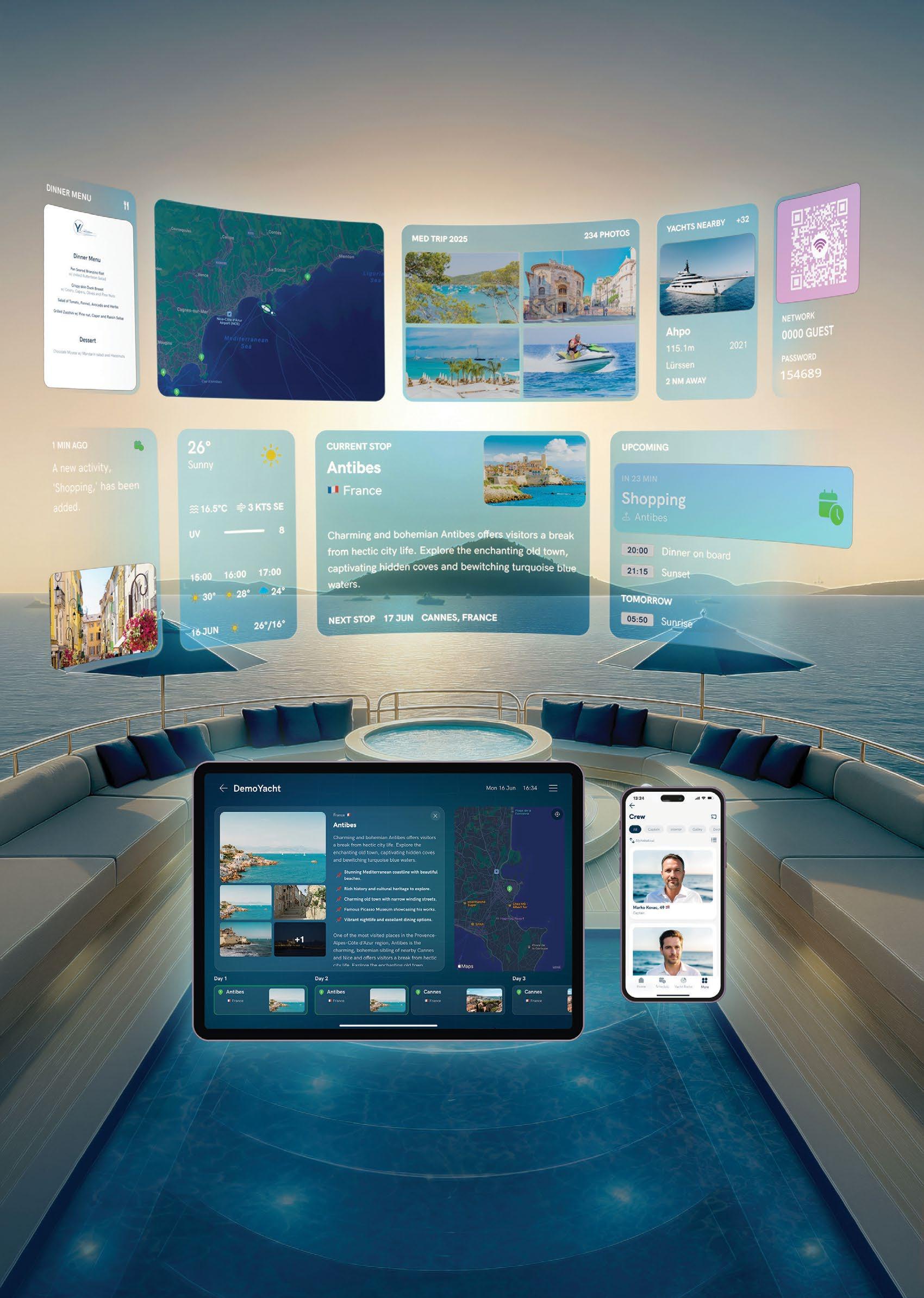





























5 yacht types, 121 solid and metallic color shades, and endless color combinations for hull, superstructure, and bootstripe – that’s our digital ALEXSEAL color configurator. The perfect tool to choose your favorite color shades.
From now on, there are many chances for a first impression of your new yacht’s surface.
Scan the QR code to explore the color configurator →
instagram.com/alexsealpaint linkedin.com/company/alexseal-yacht-coatings